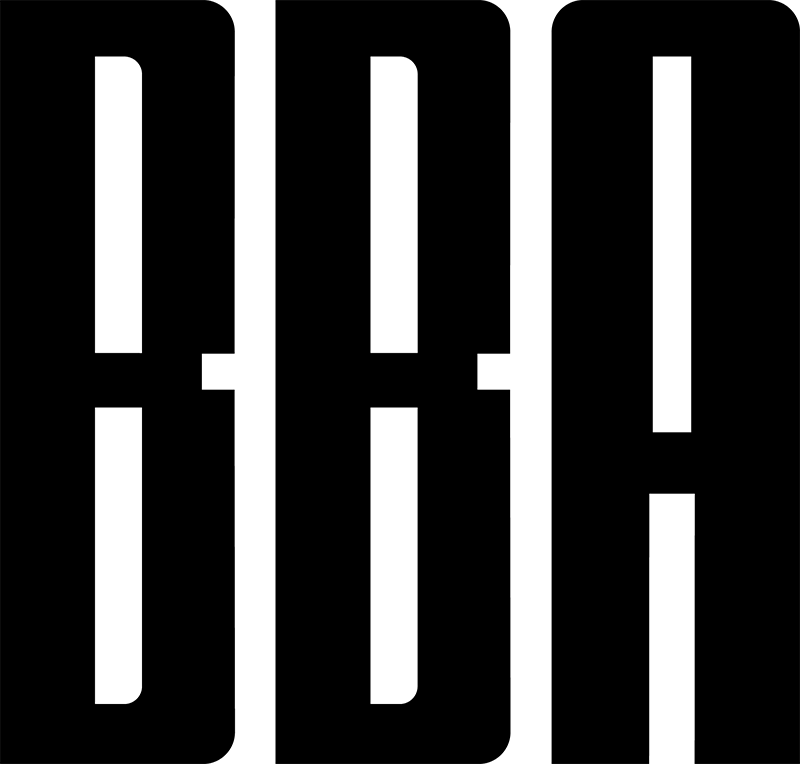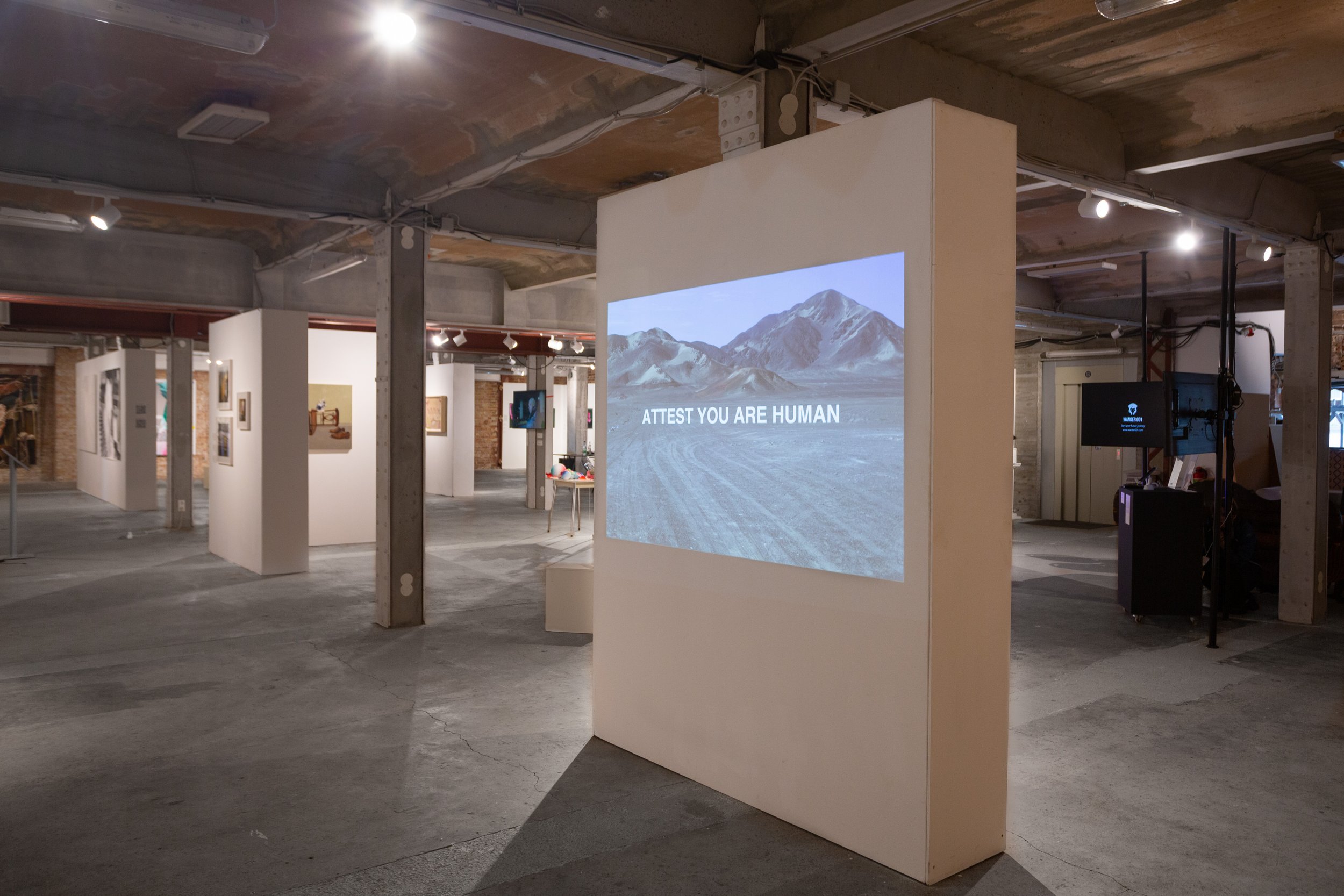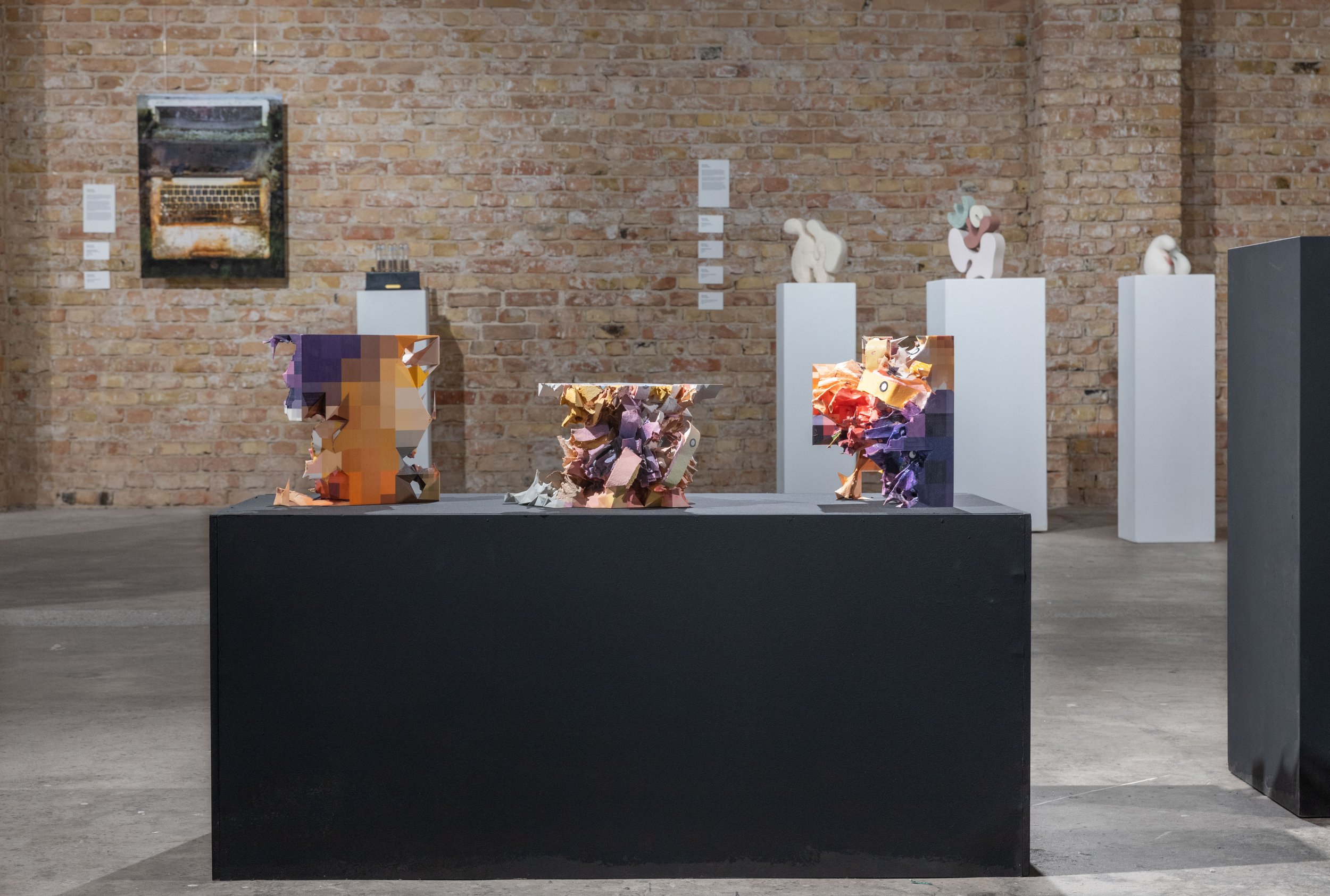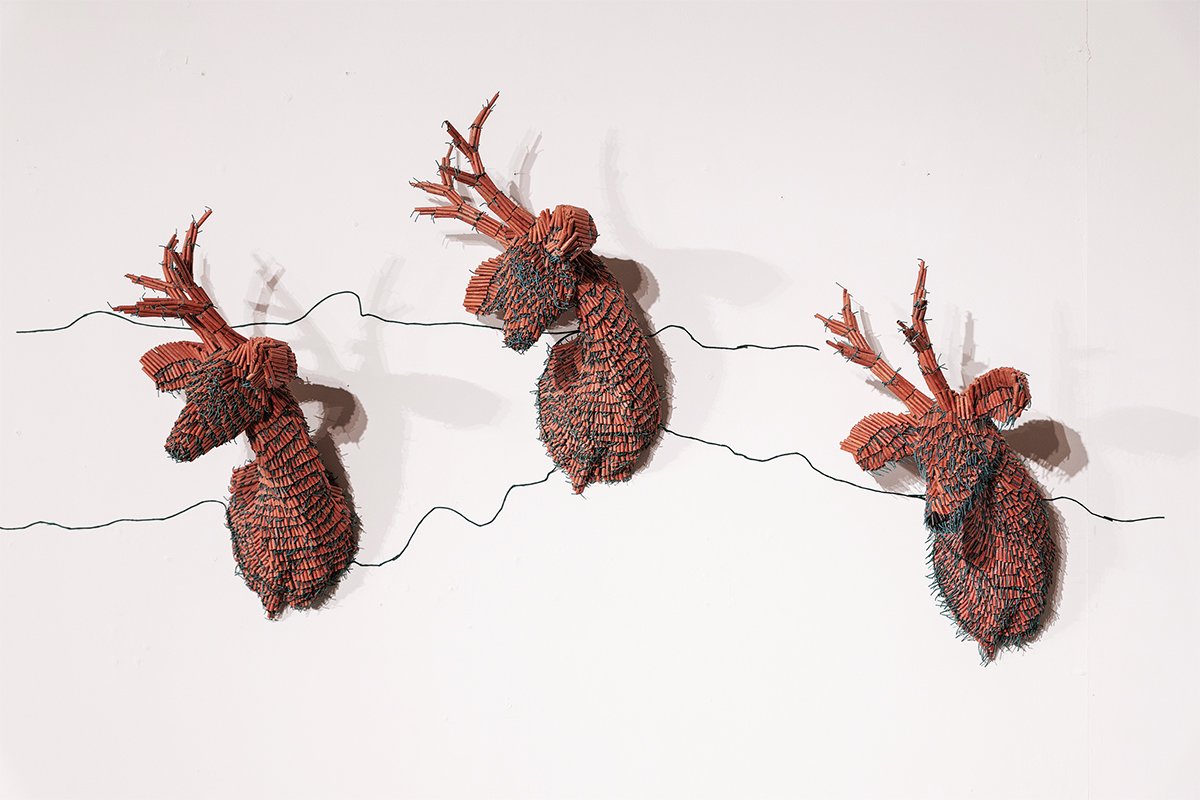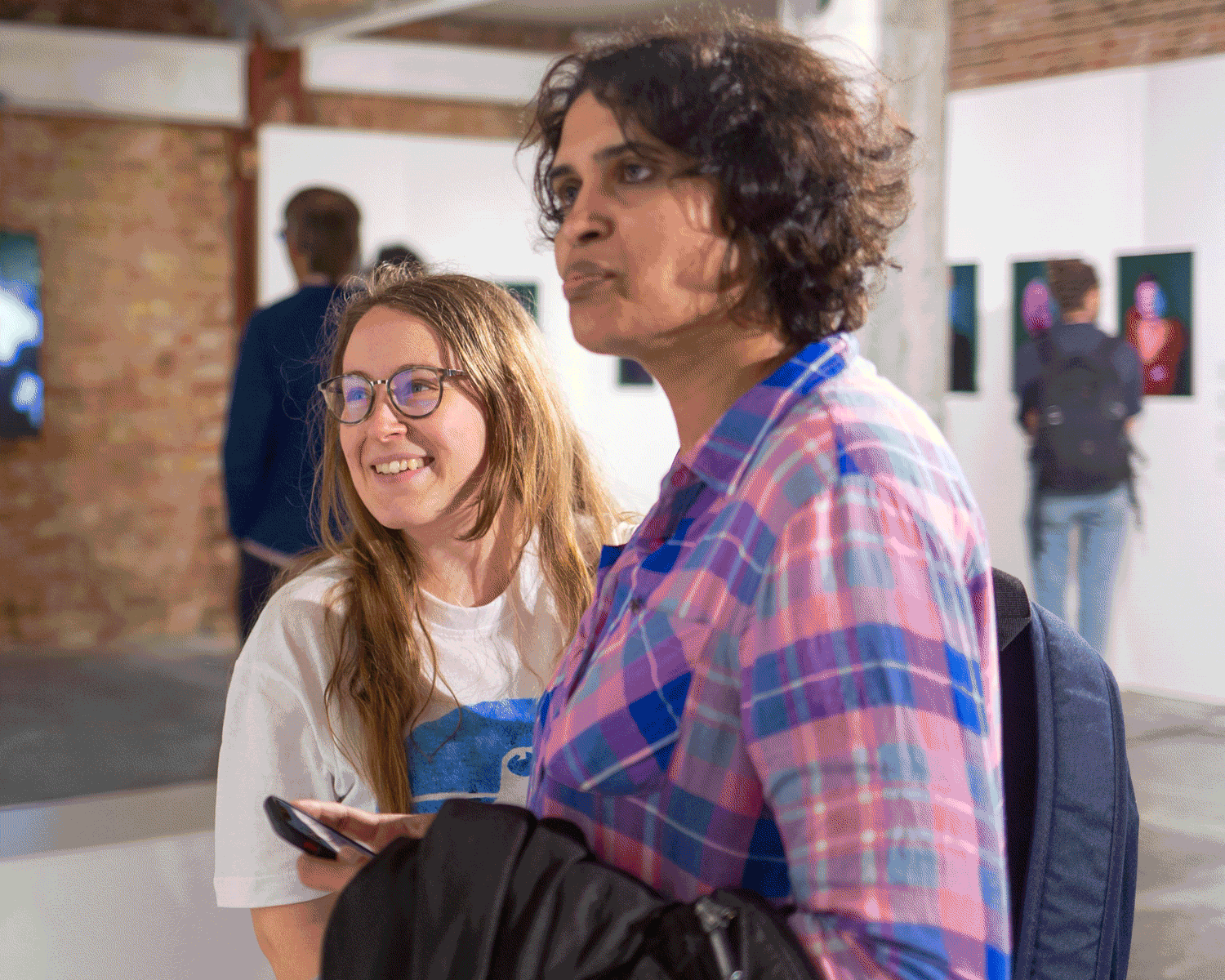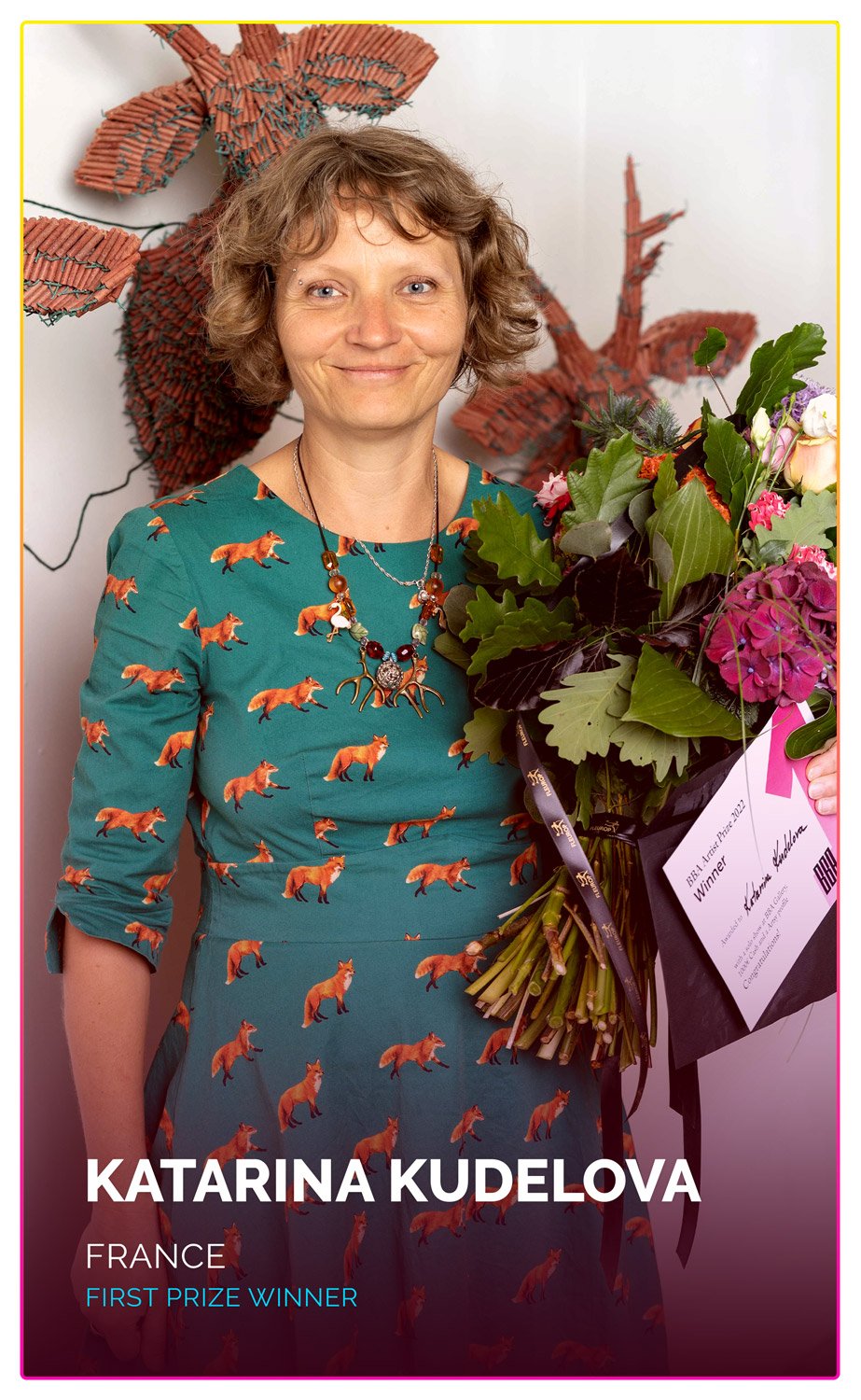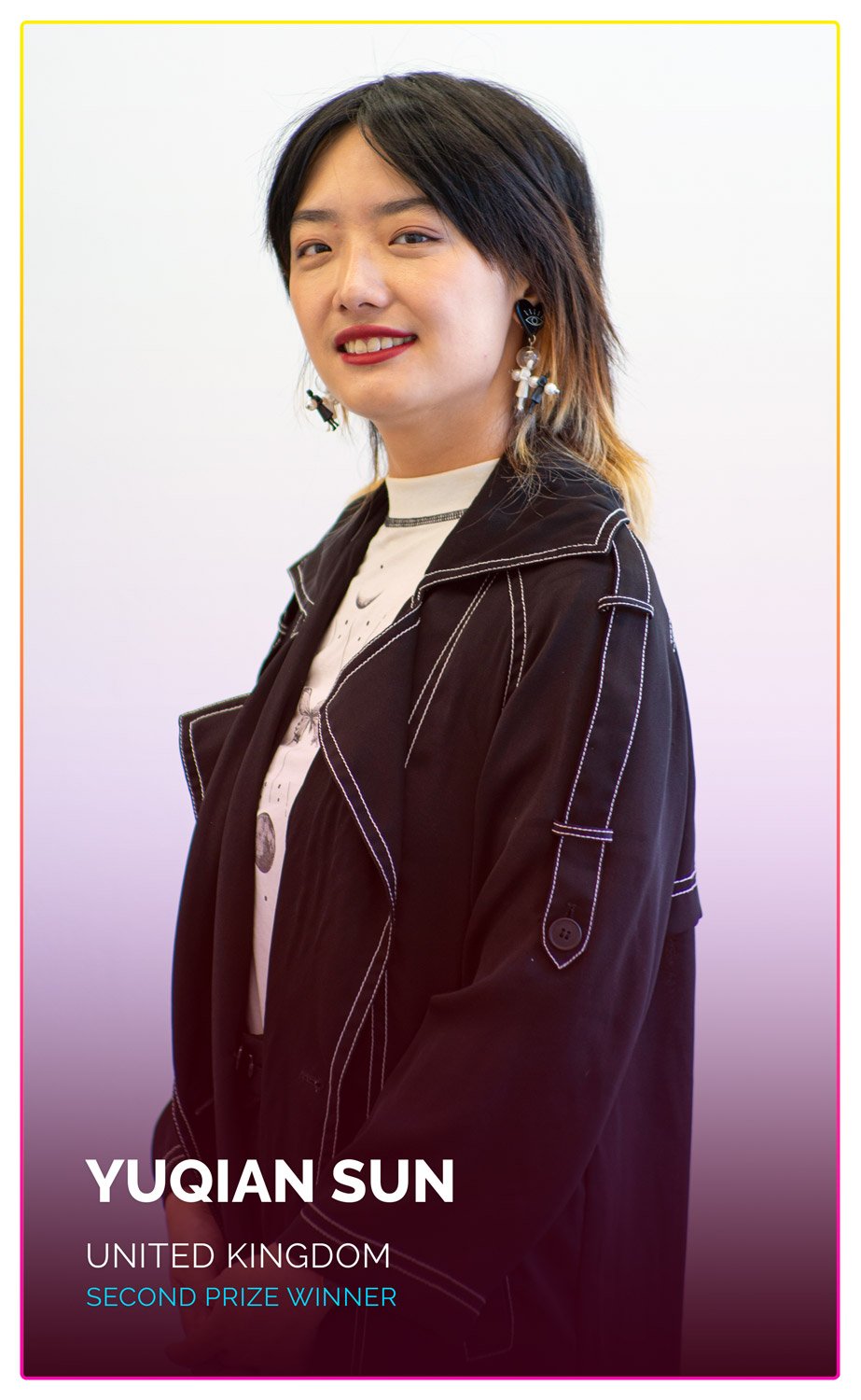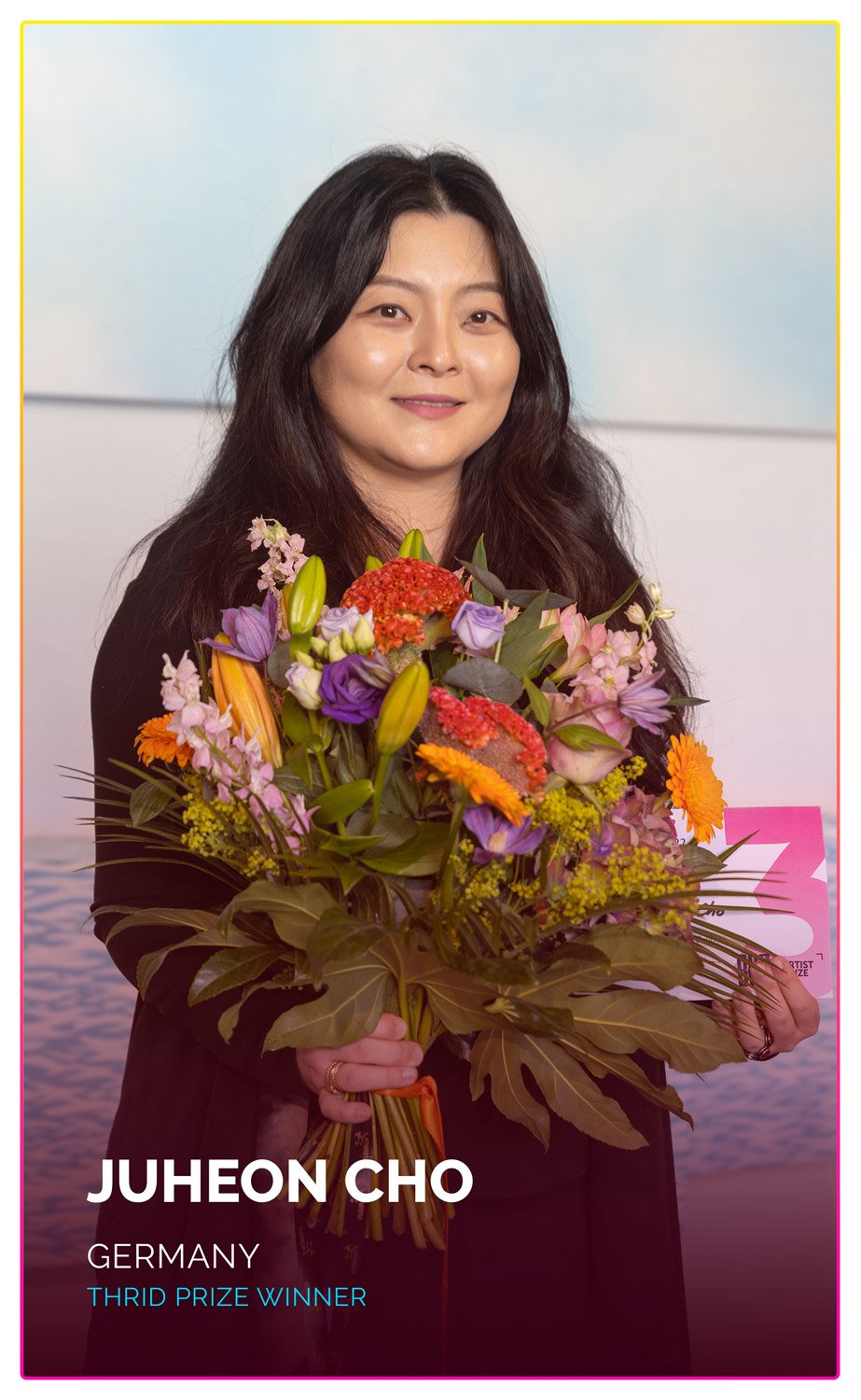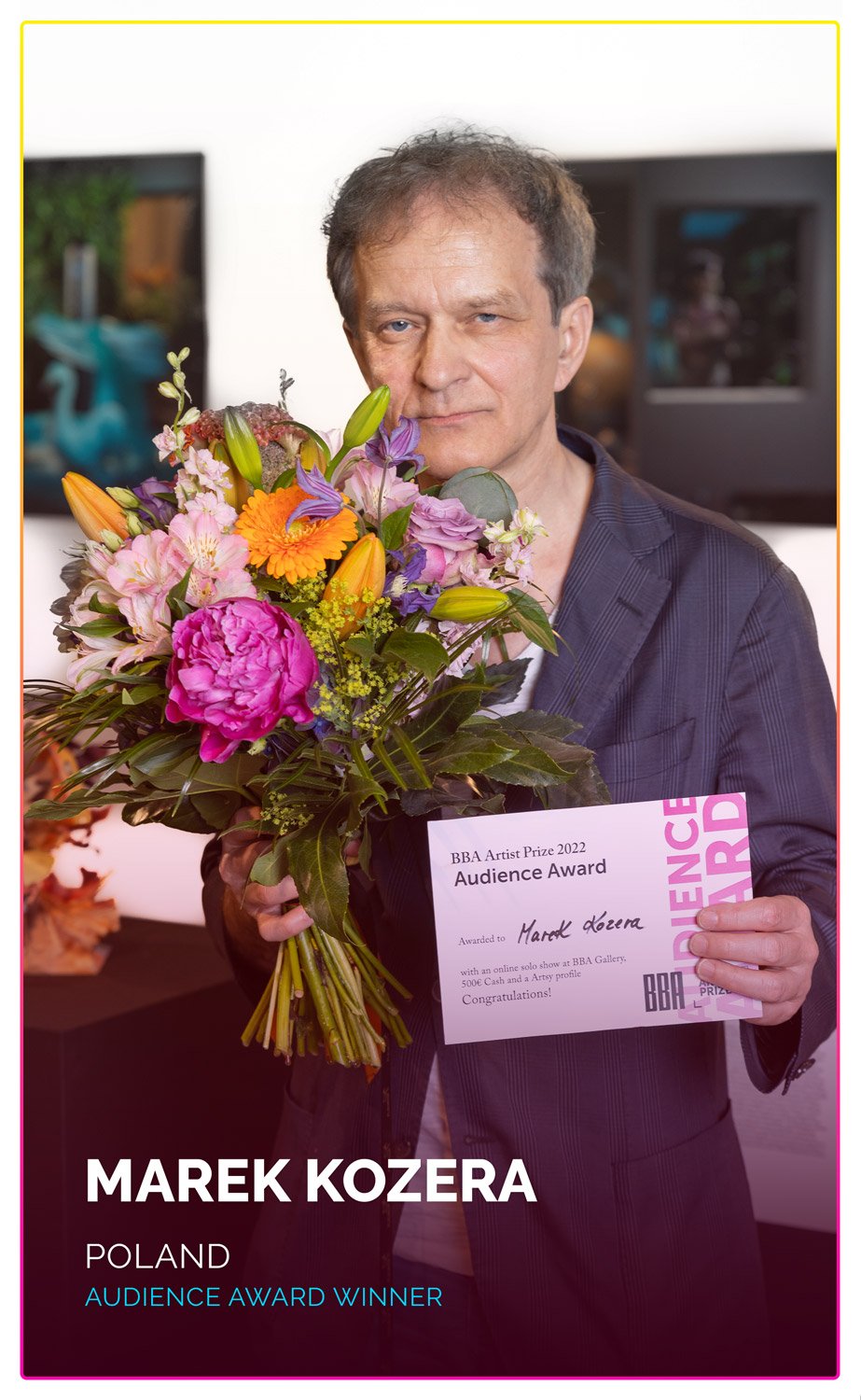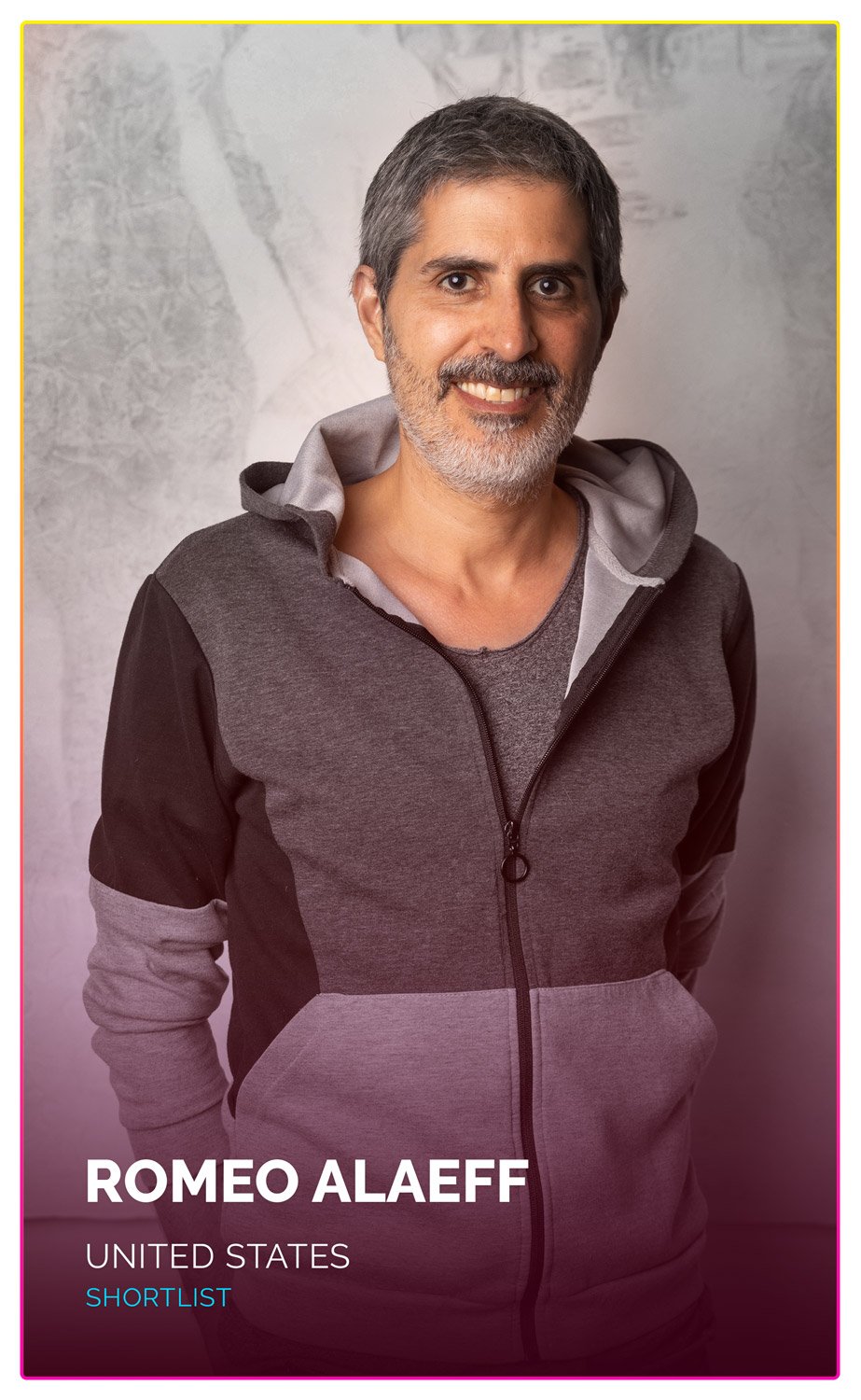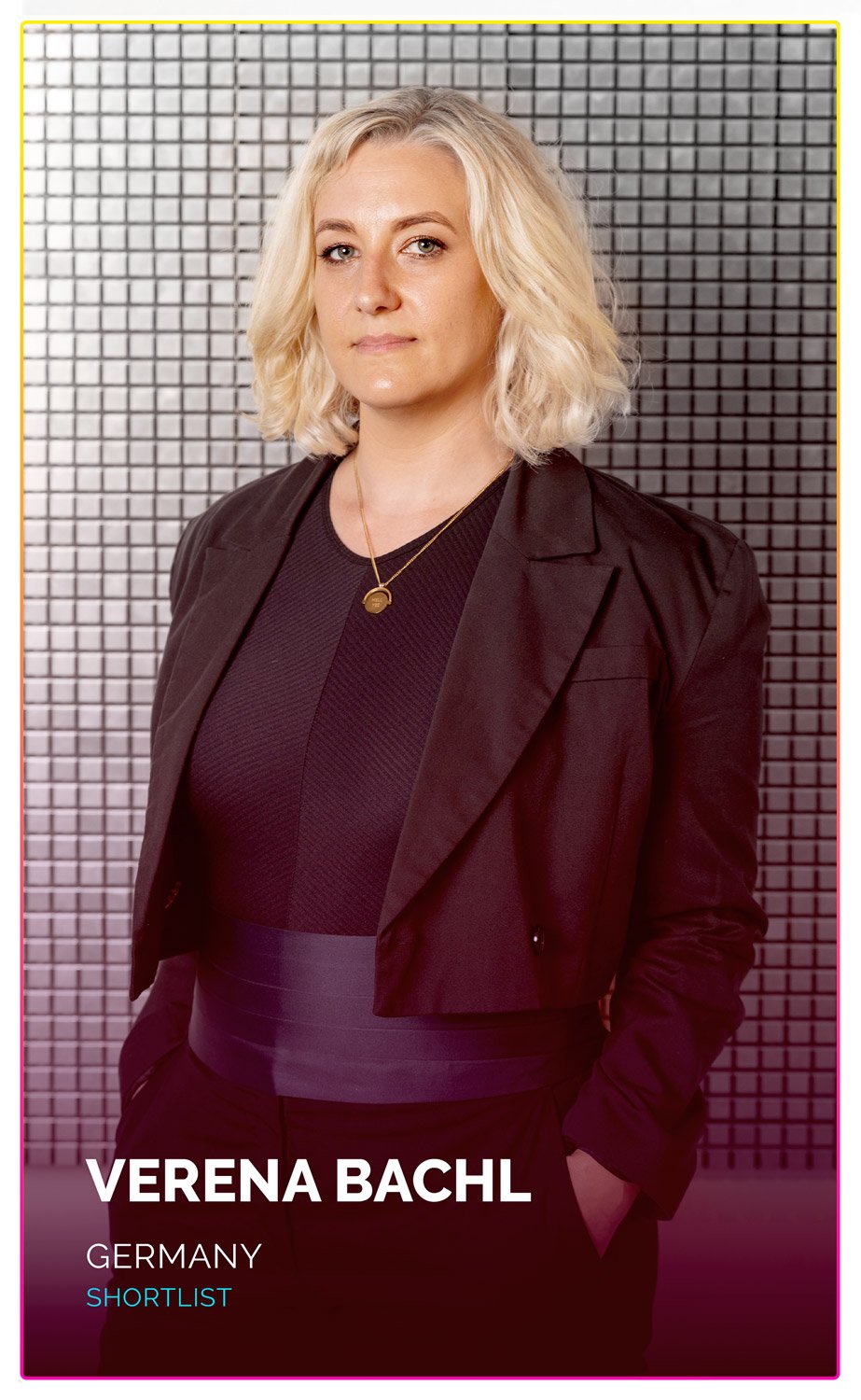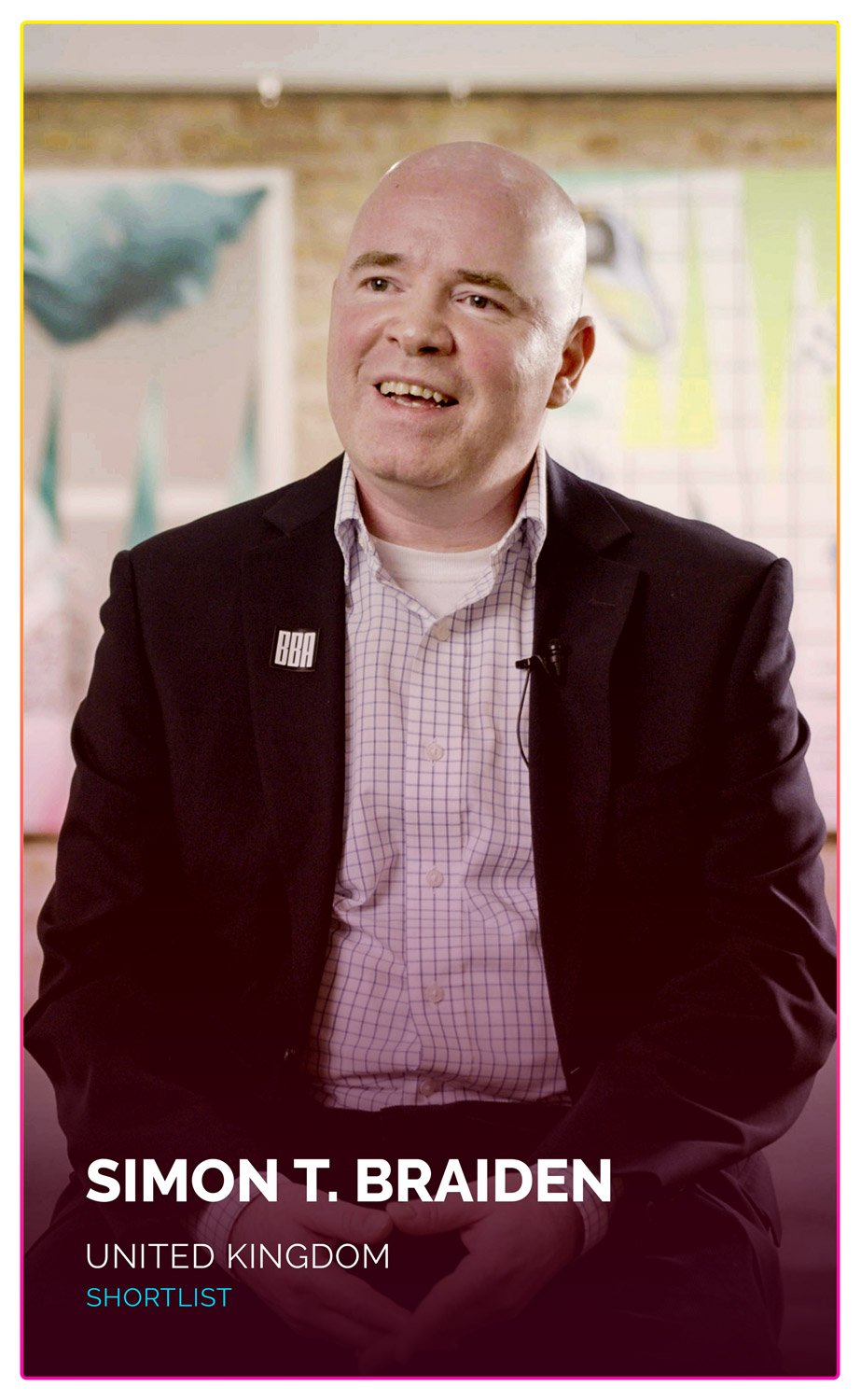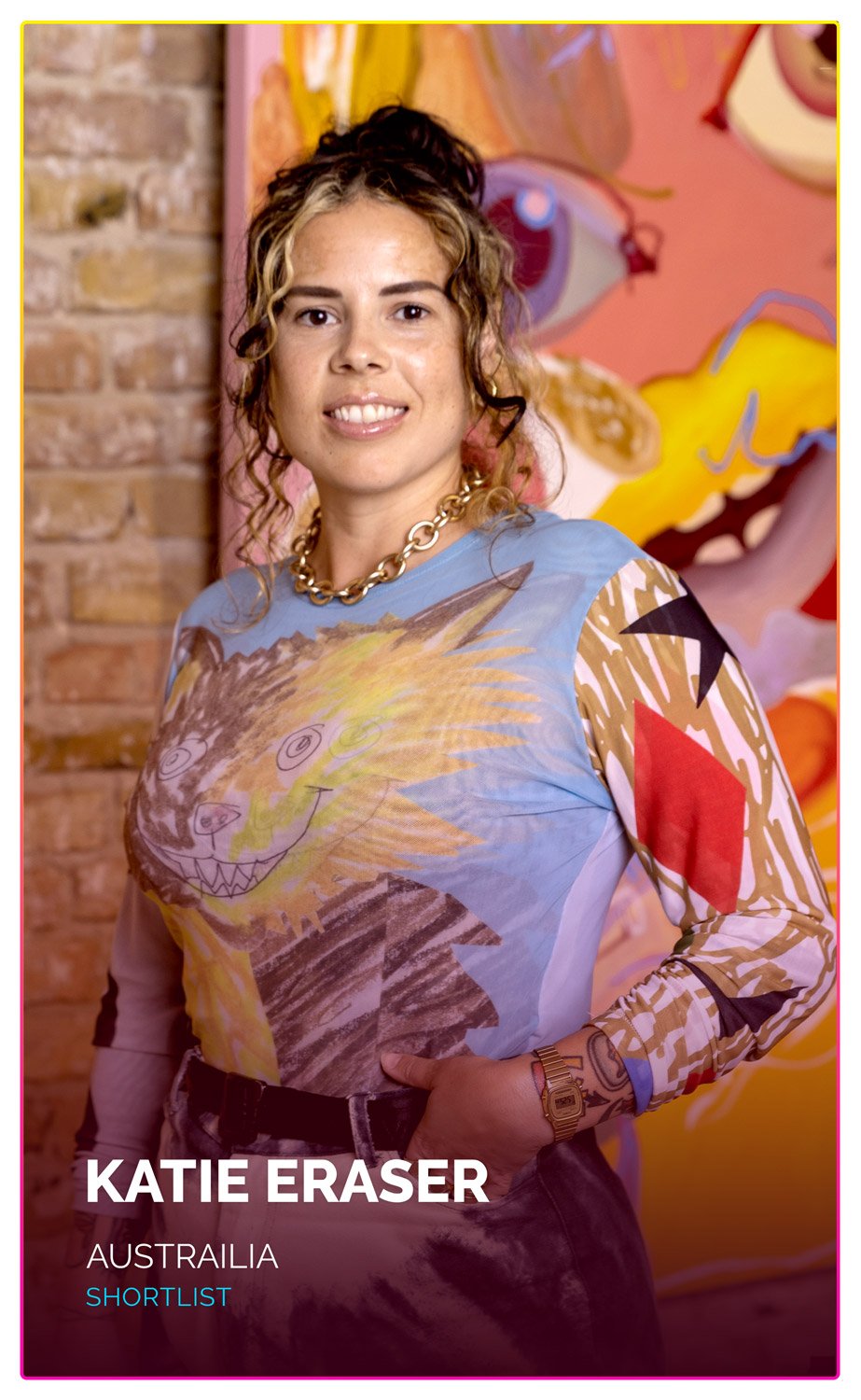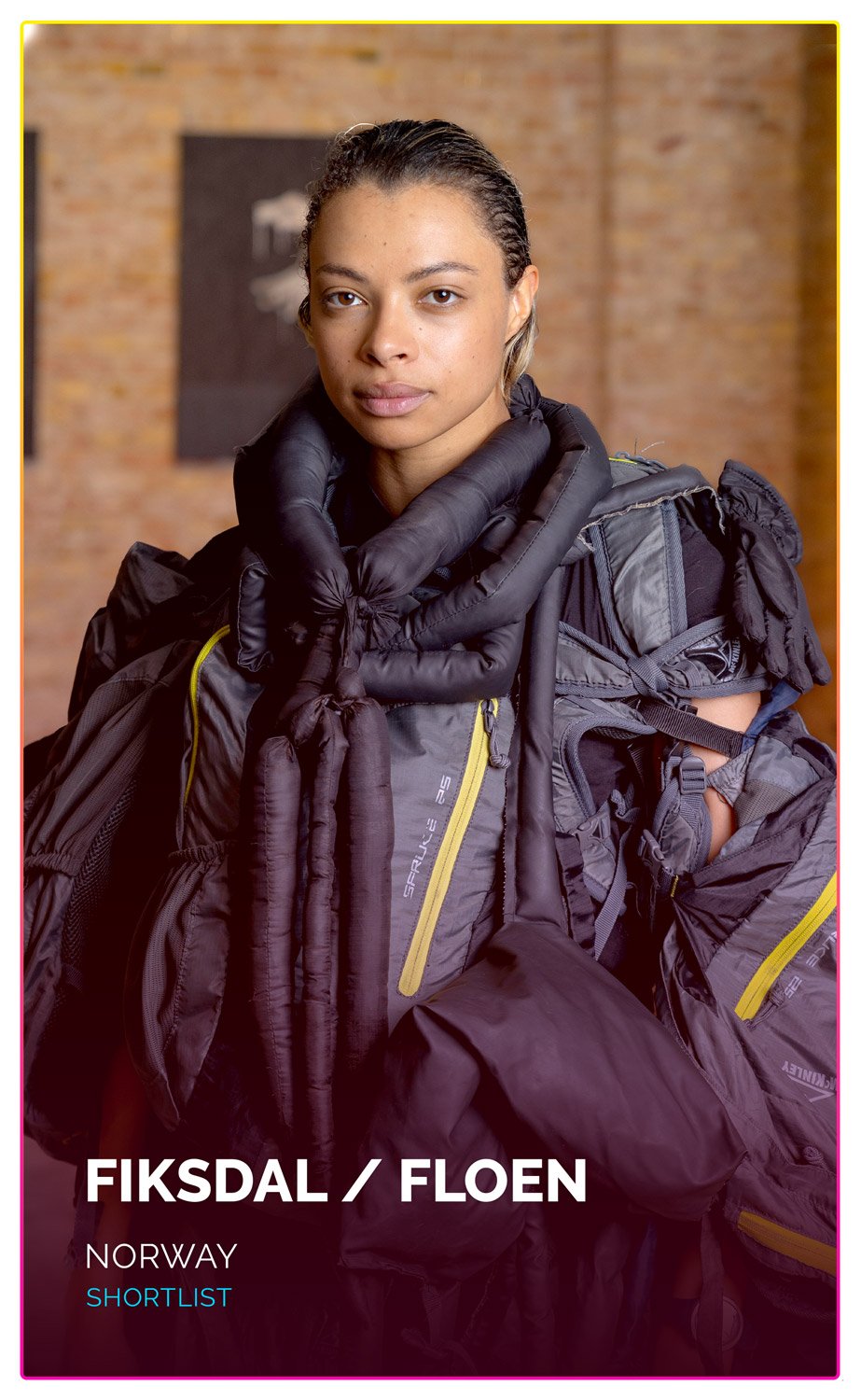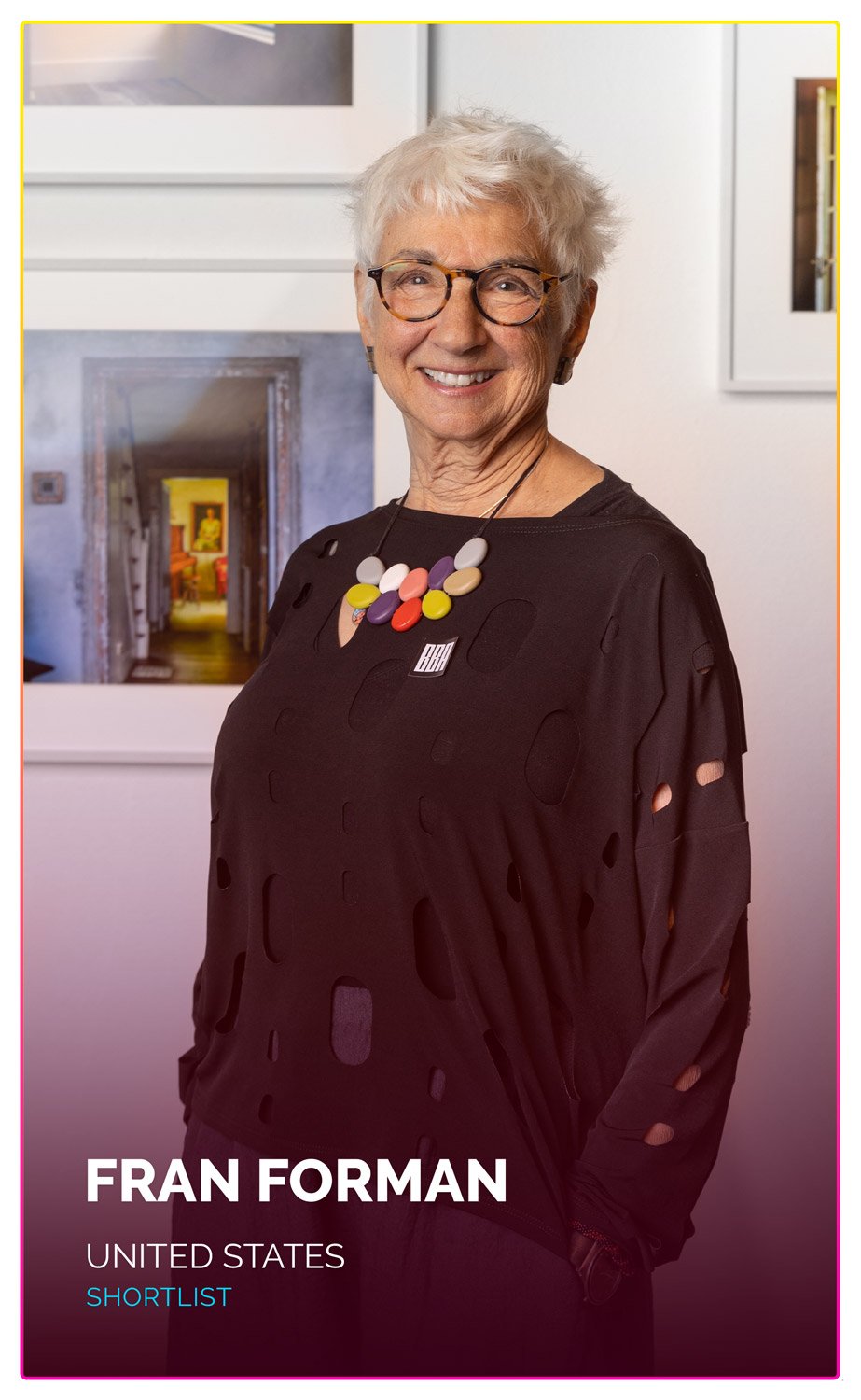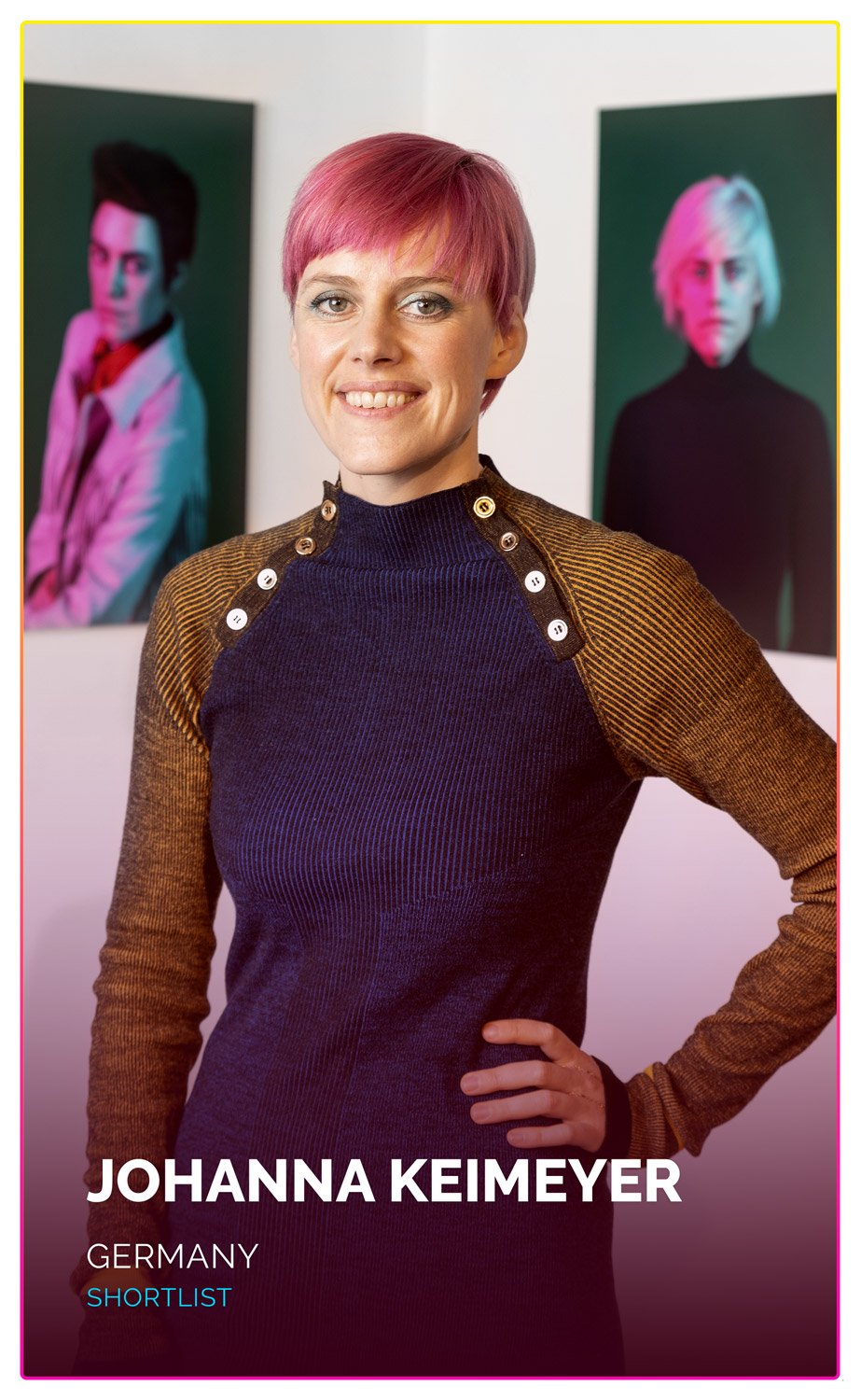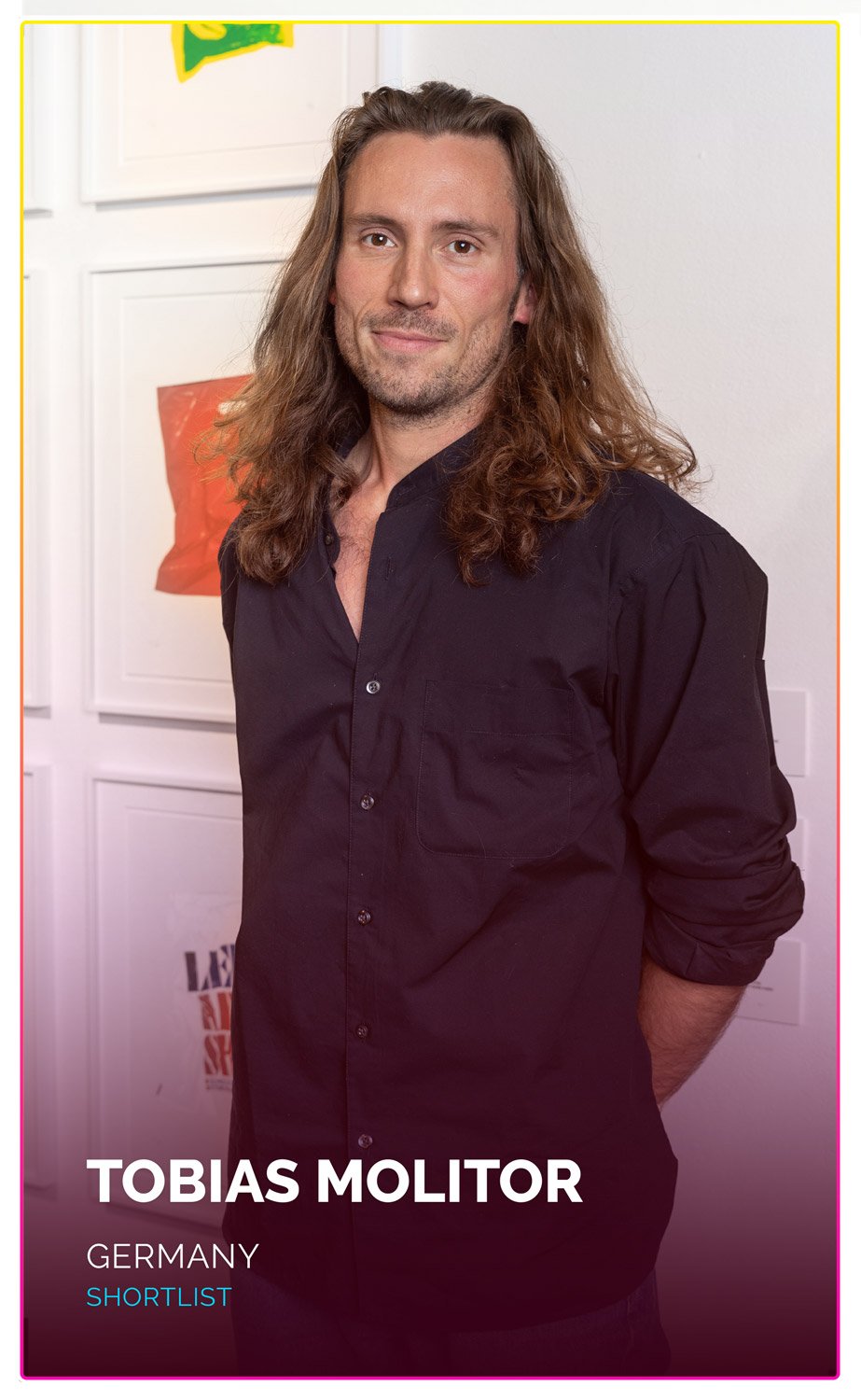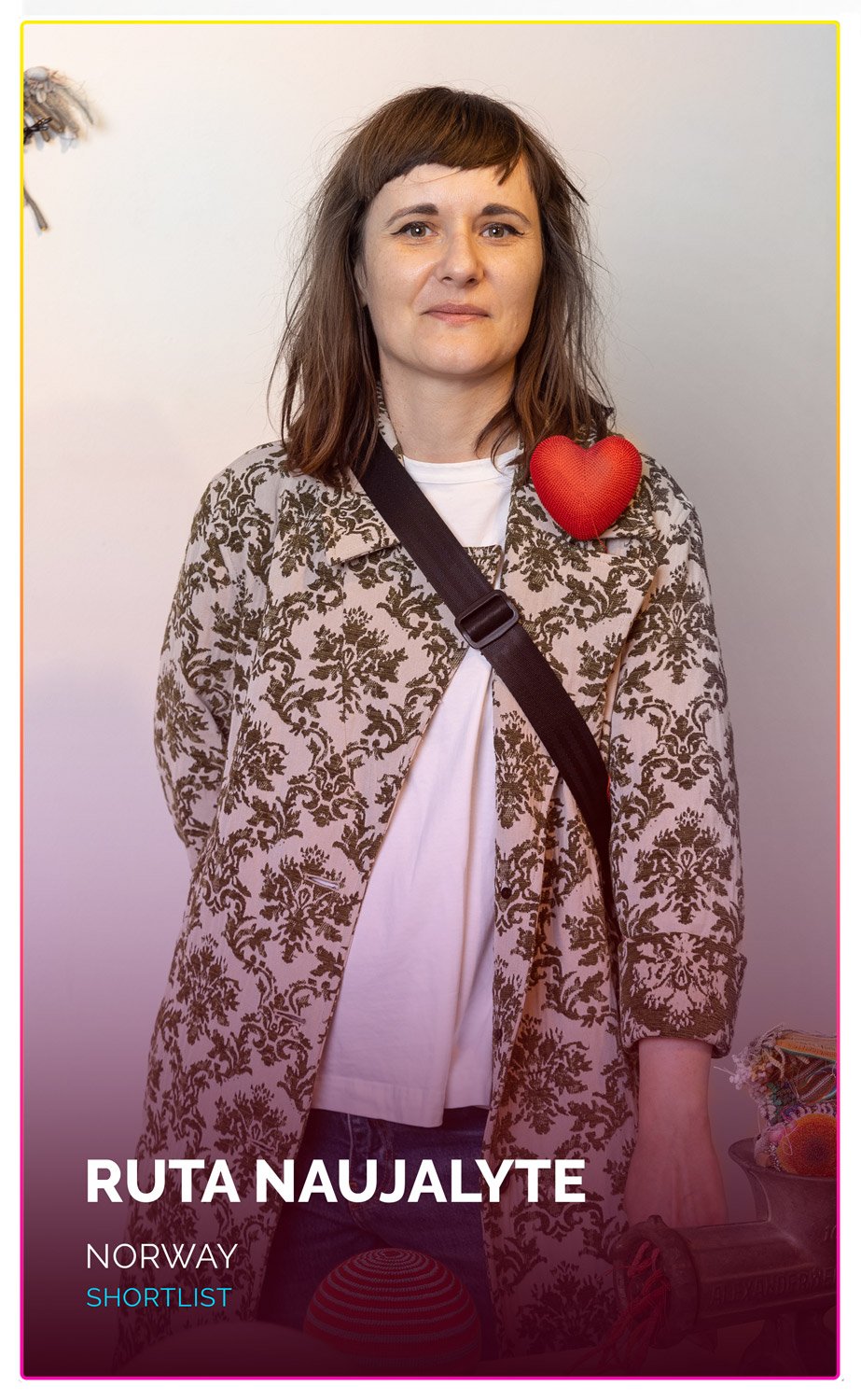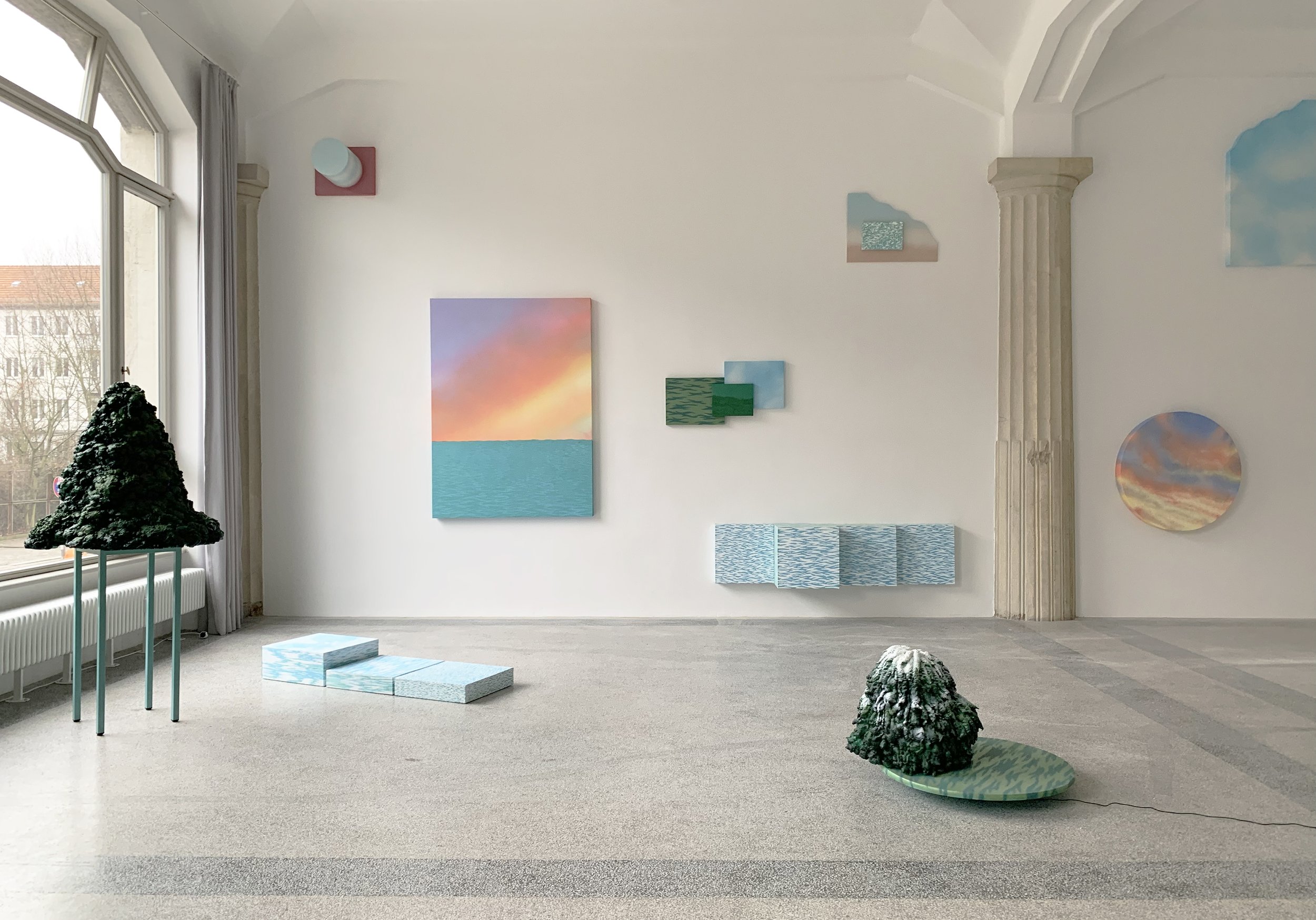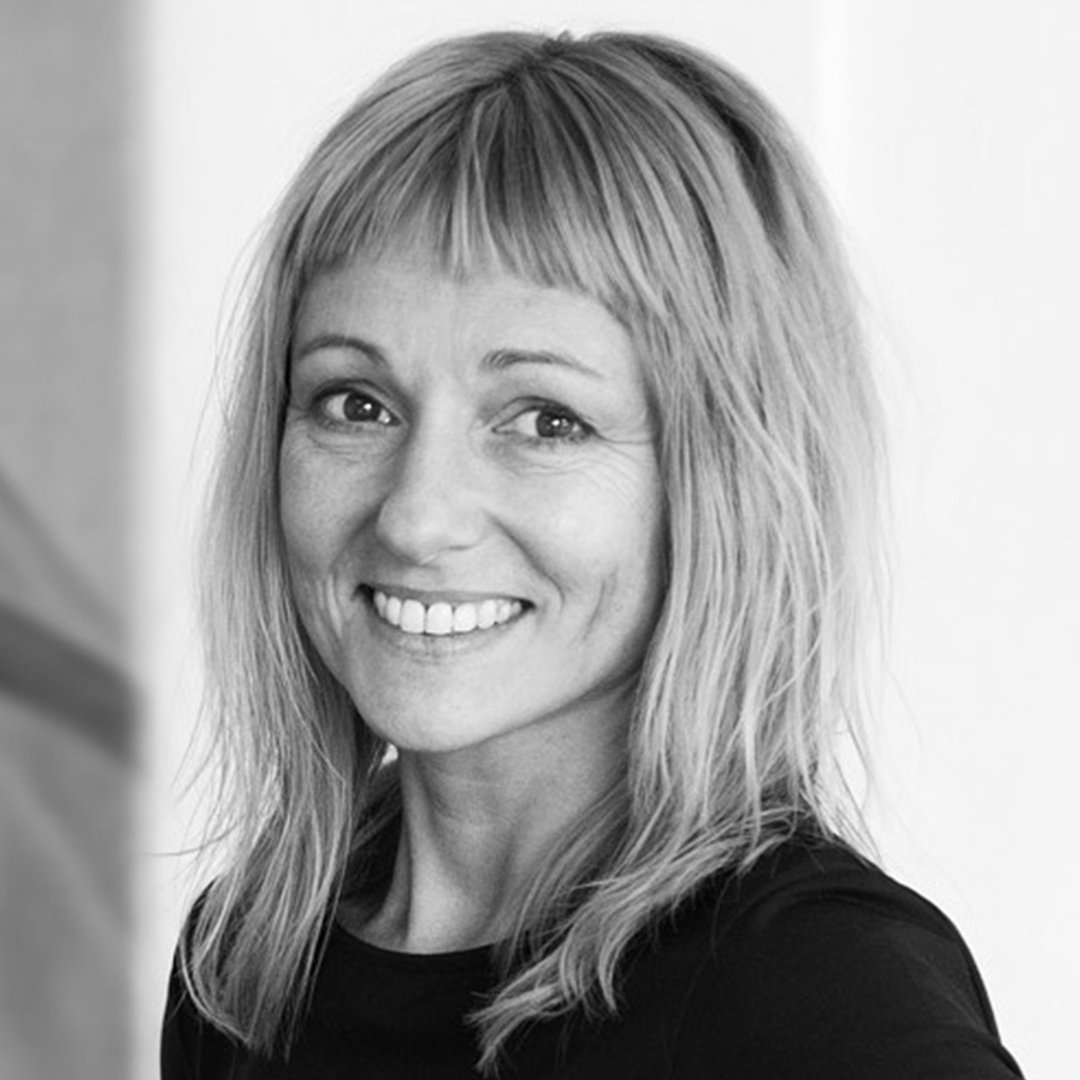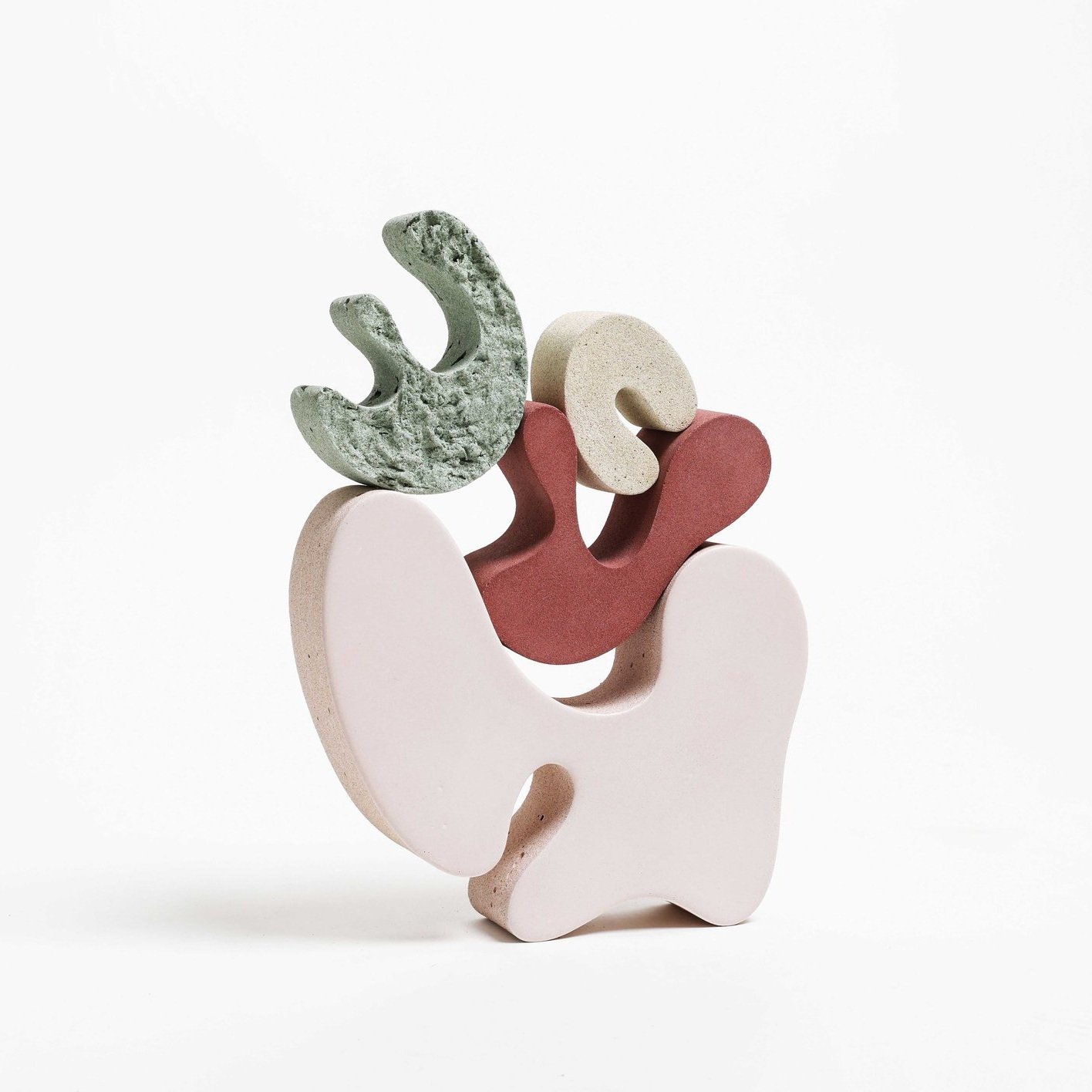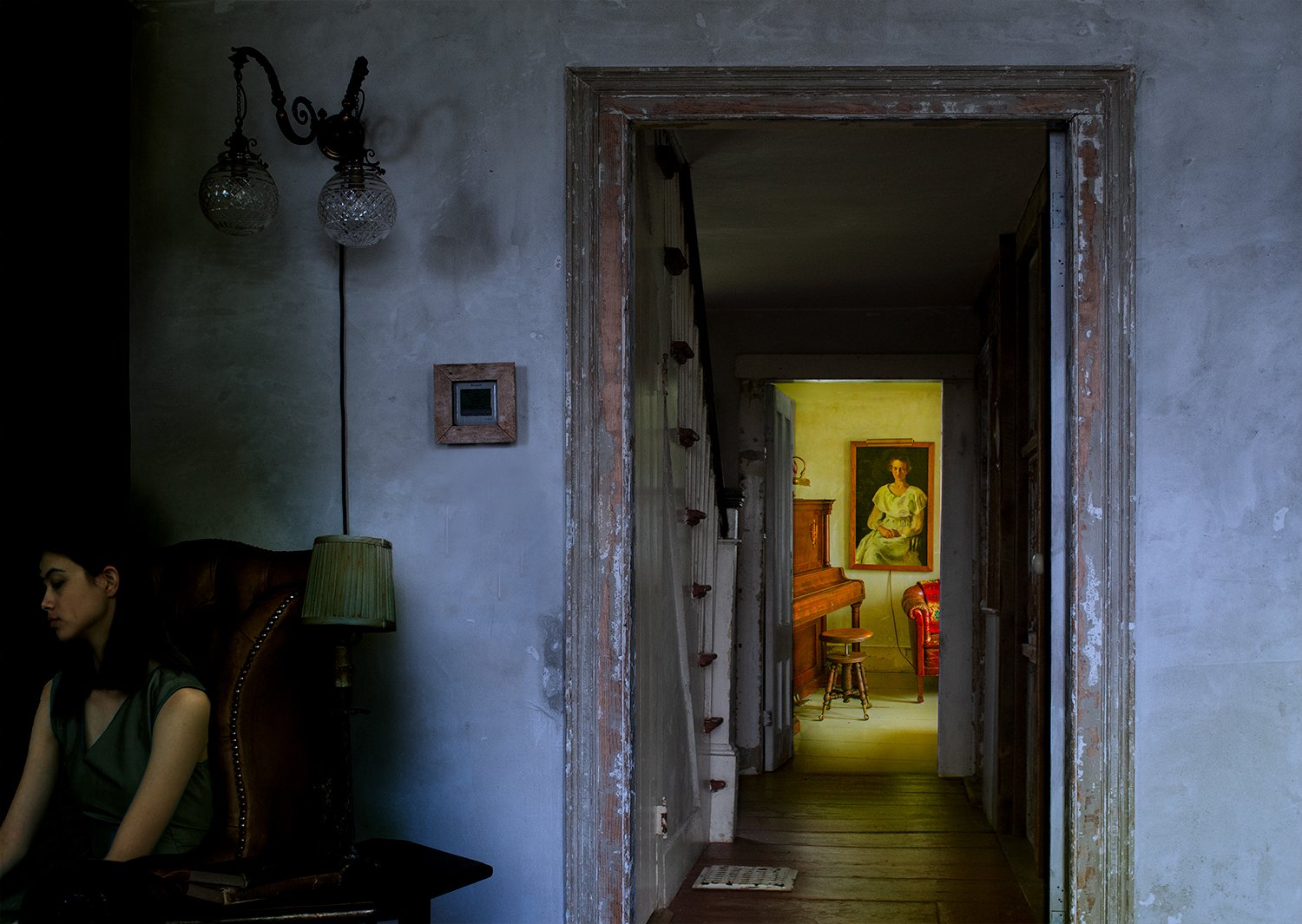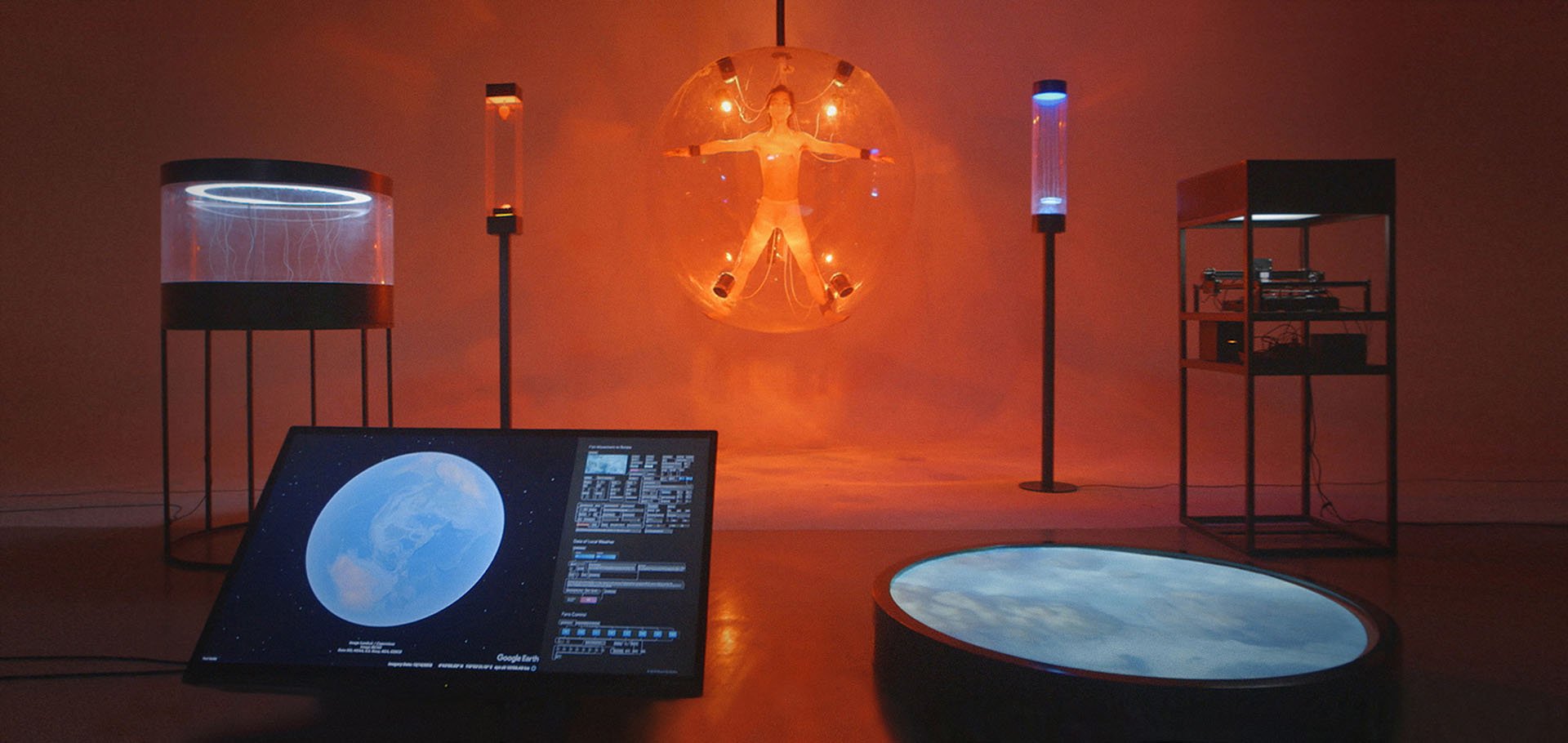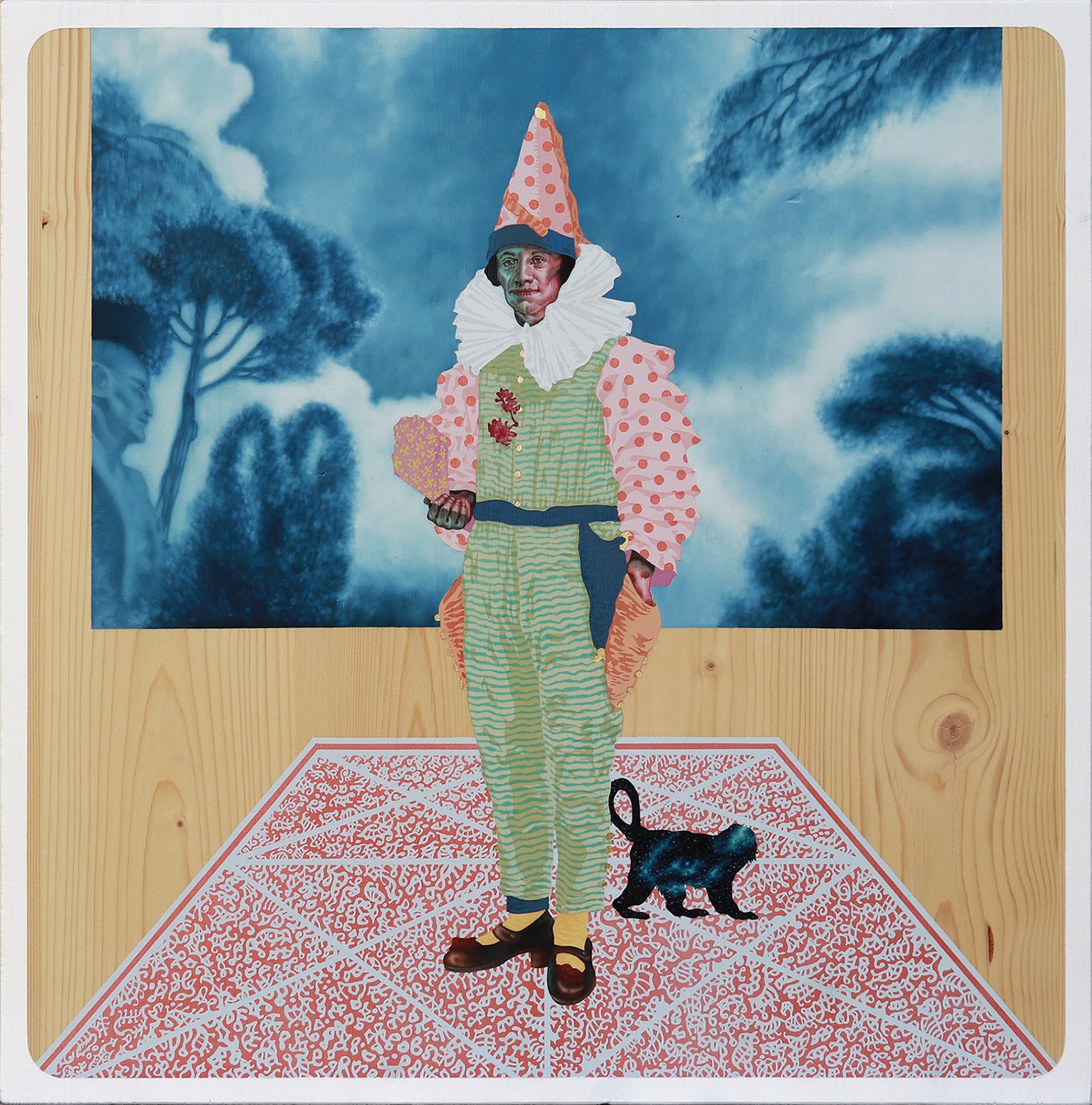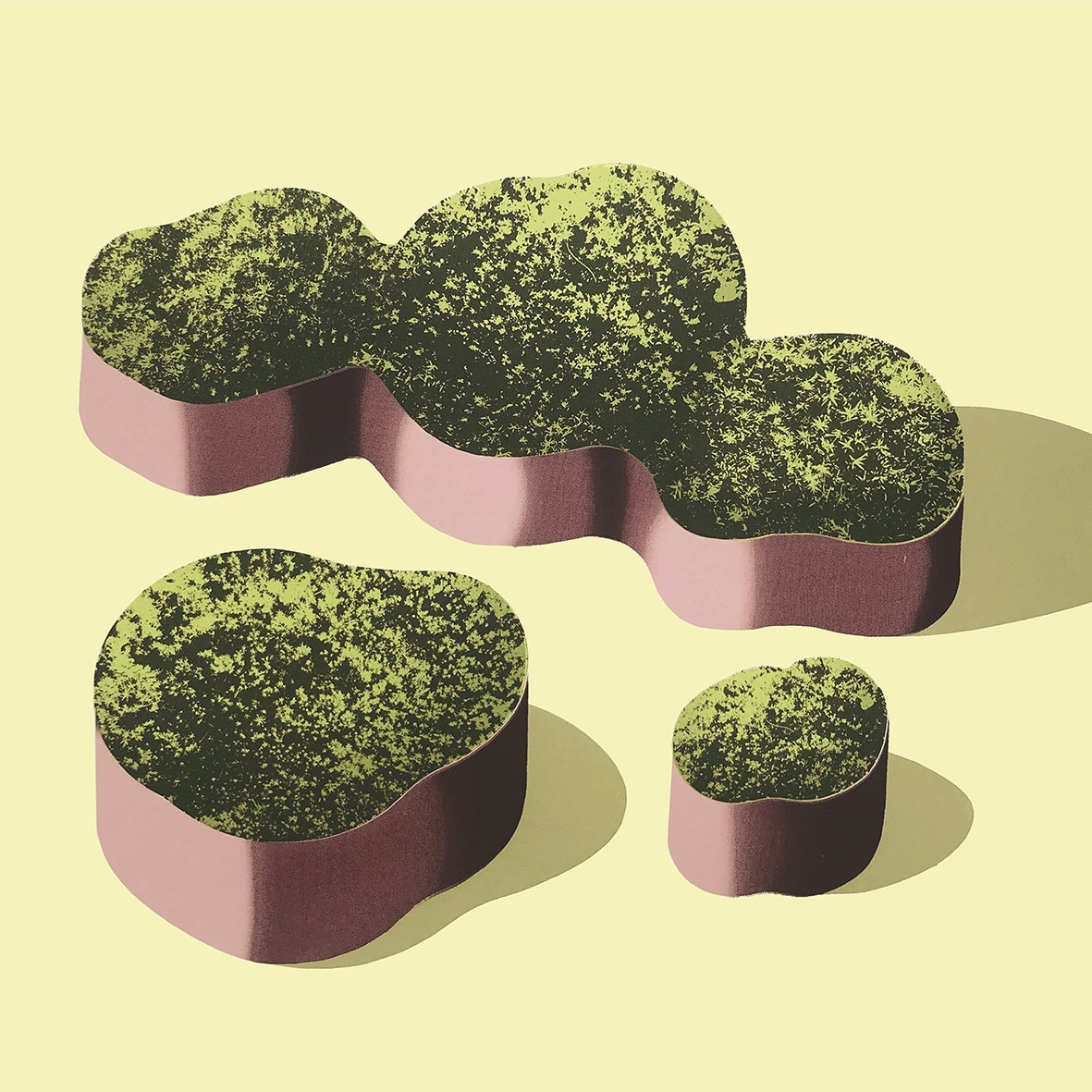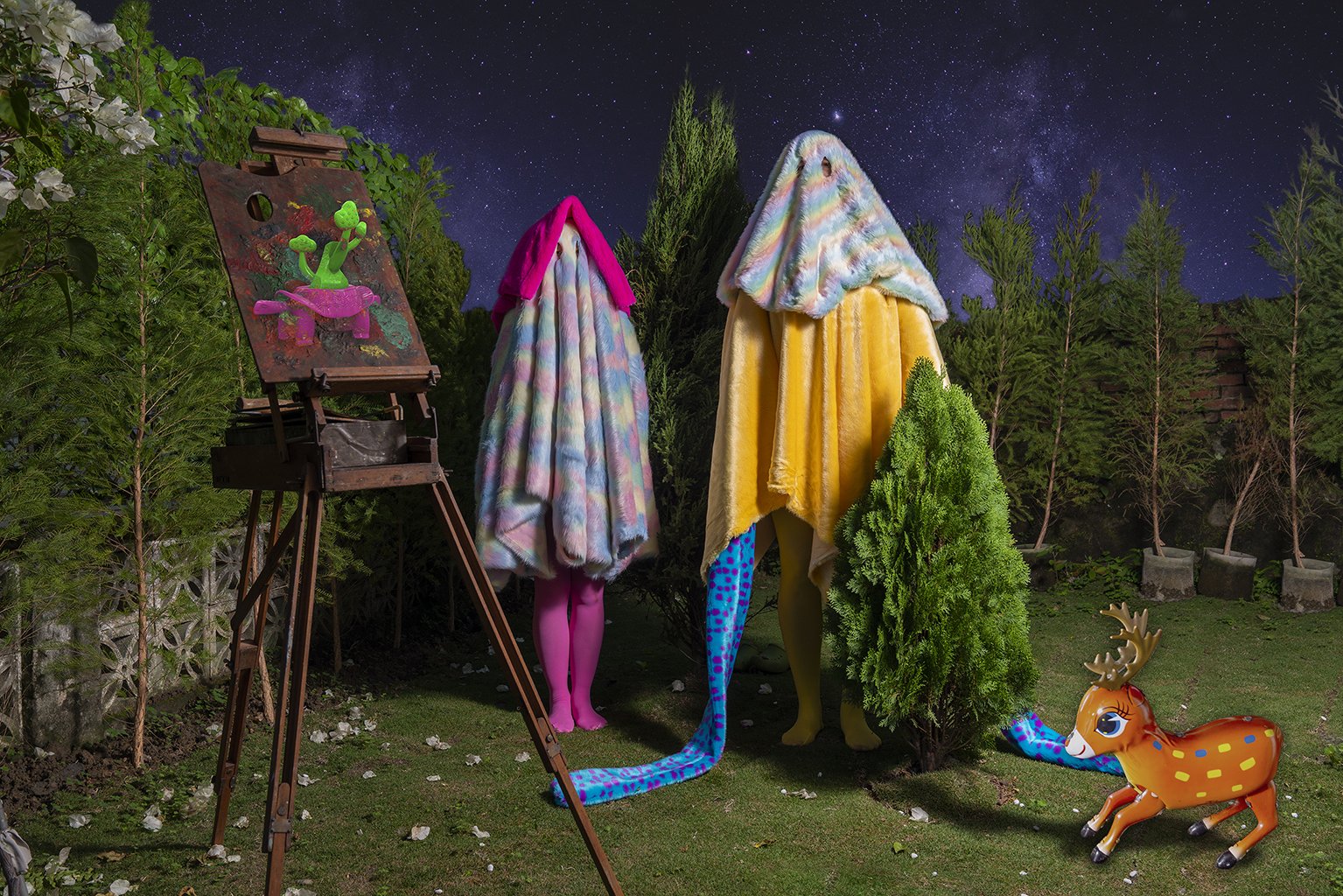BBA Artist Prize 2022
About the 2022 edition
Now in its 7th year, the BBA Artist Prize honors emerging artists. Together with an international jury, Berlin-based BBA selected 25 artists whose works were in a joint exhibition in the Kühlhaus Berlin. On 4th June at 20:00 the jury announced the four winners. The first prize winner will receive a solo exhibition in the BBA Gallery.
Meet the artists
Marek Kozera (Poland) receives the People’s Choice Award for a meticulously staged series with which he explores a new theme of “Thing-beyond-thingness”. Juheon Cho (Germany) receives the 3rd prize for her carefully designed art and sculptures, which bring back the memories of places, peoples, and events. The 2nd prize was awarded to Yuqian Sun (UK) for her digital work which studies the interaction between AI and humans. And finally: The 1st prize goes to Katarina Kudelova from France for her explosive work which explore questions relating to life and death, destiny, and fragility.
25 Shortlist artists
-
In an escalating “culture of fear,” amplified by politicians, entertainment-news, and social media echo chambers, there is an increasing predisposition for assumption, confirmation bias, conspiracy theories, and “alternative facts.” Reactionary, defensive postures become normalized—and in the social media space, monetized—and increased intrusions of security or “security theater” propagate the public sphere. Meditating on this phenomenon, "Life During Wartime" aims to engender a sense of mystery and uneasiness by merely inferring that something is awry; it is conceived such that the viewer must make narrative leaps about—and across—images. Ghostly, large-scale watercolors depict banal, yet ominous landscapes against which an implied narrative unfolds—a narrative whose intentional ambiguousness allows it to become intertwined with the viewer’s narrative projections, a priori assumptions, and cognitive biases. Charcoal drawings depict more specific “situations,” single-frame stories that one can’t quite put their finger on. Together, the work creates a vaguely familiar world constructed as much by the viewers’ projections as the work itself. Romeo Alaeff is a Berlin-based artist from Brooklyn, New York. He received a BA in Photography from Tulane University in 1993 and an MFA in Photography from the Rhode Island School of Design in 1996. His work has been exhibited internationally in major museums and galleries, and he has been a guest artist at the Rhode Island School of Design, Brown University, Pratt Institute, and Parsons. His most recent photobook, "In der Fremde: Pictures from Home" (Hatje Cantz, 2021), is a cinematic view of Berlin and the search for "home."
-
Van Breevoort is fascinated by mankind’s urge to manufacture everything around itself to its wishes. Much like the way we shape and try to make sense of the world through rules, laws and other organisational structures. In her work she tries to emphasise a network of contradictions which include the dialectic between man and nature and the organic versus the technical. Boundaries between animals, the man-made and man are blurring. Through an intensive process of sculpting, making moulds, casting in specialised silicone and even adding real hair where necessary, a surrealistic yet believable world is created. Thus the viewer is misled into thinking this absurd world could be a reality. Van Breevoort puzzles about a nature that can only exist under the condition of man and tries to reflect this doubt about what people call nature in the Anthropocene, in her work. Questions about authenticity therefore drive the creation of many of the works she makes. Can we still speak of the “natural” when everything that man considers to be nature has been influenced by and exists by the grace of man Himself? Margriet van Breevoort lives and works in Amsterdam, she studied at the Hogeschool voor de kunsten Utrecht and received her diploma with honours in the year 2013. She has had multiple successful solo exhibitions and has taken part in international Art fairs including Scope Basel. Her work can be seen in institutional collections in the Netherlands like Museum Arnhem and Buitenplaats Doornburgh.
-
Mirjam Hinn (born 1990) is an abstract artist who lives and works in Tartu, Estonia. Some of the key themes in her practice have evolved from her fascination with the phenomenon of synaesthesia, the idea of blended senses. Hinn is interested in investigating how it is possible to visualize experiences on canvases, for example hearing sounds (exhibition Solidified Sounds), sensing light (exhibition The Light Begins to Boil) or experiencing emotional shock, for example exhibition High Voltage which focuses on issues of inward human experiences by exploring the intense states of mind and their role in being human. Her latest exhibition “Island of a Thousand Eyes” offered an original glimpse of the post-technological society where ideas about nature and artificial structures have become intertwined. She has graduated from University of Tartu, Department of Painting MA (2018), Tartu Higher Art School (2014) and Tartu Art School (2010). She has participated in numerous joint and international exhibitions since 2011, first in Estonia and then also in Finland, Lithuania, Belarus, Italy and Germany, including NordArt, ArteLaguna, CombatPrize etc. Most of her personal exhibitions have taken place in Estonia, where she ́s been awarded with the AkzoNobel Art Award 2018, Young Tartu 2019 and nominated for the Konrad Mägi Award 2020. Her works can be found in numerous private collections and institutional collections like Tartu Art Museum, Nuvole Arte Gallery and Art&Tonic Gallery. She is member of Estonian Artists’ Association and Estonian Painters’ Association. Her next personal exhibition Floating Perspectives will take place in Montesarchio, Italy (2022).
-
Jiaxi [镓汐] Li’s work explore escapism as a self-protecting mechanism in a biographical format. As a mortal existence, human beings inhabit and interact with spaces physically and spiritually. Brimming over with objects that allude to the deepest self, the domestic environment encloses the traces of humanity, history, and relationships. Jiaxi sanctifies and places reverence in the everyday and the neglected. Knot by knot, start with threads, by changing the nature of knit, she builds 2D and 3D sculptures from the material that should not stand up. A re-enactment of her environment — as a type of vagabond, isolated from family, pandemic restrictions, pixelated information — resulted in a new relationship with home. Jiaxi is a London-based textile artist who focuses on innovative knit practice with a multicultural background. Before her master’s studies at the Royal College of Art, Jiaxi majored in fashion design at Parsons School of Design in New York. Her accolades include a solo exhibition and residency at Unit 1 Gallery and group exhibitions ranging from New York, London and Beijing.
-
There exists a space between our outward appearance and inner self. It is a space lined with objects that carry a record of our experiences and a glimpse into our past. Heather V McLeod’s work explores this space. Through non-traditional portraiture, Heather uses familiar objects to explore aspects of our daily lives. Her most recent series utilizes 19th Century porcelain figurines set in precarious situations. These scenes are both familiar and cringeworthy, relying on our associations with porcelains and their theatrical presence. A figurine threatening to topple over the edge of a chair speaks to the fragility of the feminine form. A pair of shiny leather shoes adds a human presence to a courting we’re not sure is welcomed or stable. These oil paintings focus on the fragility of relationships and the humor found in even the darkest of conflicts. Heather V McLeod is a recent graduate of The New York Academy of Art and Rhode Island School of Design. In addition to her full-time painting practice, Heather has completed artist residences in Nantucket, Massachusetts and Tribeca, New York. Her curriculum vitae includes a solo exhibition in New York City’s Trotter & Sholer Gallery as well as group exhibitions at Sugarlift Gallery and Sotheby’s among others. In addition, she has received the prestigious Fulbright Research Grant to study in Italy and two Elizabeth Greenshields Foundation Grants. She is currently based in Manhattan.
-
Yuqian Sun is a Chinese AI artist and researcher. Inspired by conversations between virtual characters in video games, she produces works that steer with curiosity. With her interest in Human-AI interaction, she created Wander, an android that travels on the future earth. This work aims to create a meeting point between reality and virtuality and turns the data of familiar surroundings into fantasy. On Discord, participants can send messages to Wander of **any locations on earth**, then she would visit and send photos and interactive travelogues from a future time. All contents are generated through AI based on real-world location information. People’s journeys will show on a future earth map website. This will become a speculative chronicle explored together by humans and AI, a fiction collection to explore cyborg aesthetics.
Yuqian graduated from Tsinghua University and Goldsmiths, University of London. She’s currently a doctoral student at the Computer Science Research Centre, Royal College of Art. Her works and research have been presented at galleries and conferences including 2020 Artificial Life, The media facade of Yeltsin Center, 7th ACM Celebration of Women in Computing, ISEA 2022 and Shanghai Aiiiii Art Center.
-
David’s practice is centered around anthropology and human cultural evolution. He looks at society through a diachronic lens seeking cultural shifts which ask questions about our collective humanity and culture at a time of accelerated change. Recent research looks at digital, post-internet models of engagement and AI. These multimedia works observe our transition to an age where we need to attest our humanity to machines, proclaim our rights to data, question our cultural legacy through digital archeology, and experiment with AI futurist predictions and gamification. Examples include the Attest you are human series, which explores the randomness associated with the point in human evolution where we need to attest our humanity to machines, Jus Data, a monument to our right to personal data, and Oracle and the 5050 by 2050 series, which gamify and create future predictions for the probable date of human-level artificial intelligence. David's work is in UK and American collections and has been exhibited nationally and internationally including the Royal Academy of Arts, The Royal Scottish Academy, The London Group, and The Other Art Fair London & New York. David was long listed for The Aesthetica Art Prize in 2022 and 2019, The John Ruskin Prize in 2019 and awarded a special project by Saatchi Art for the Other Art Fair, New York in 2018. David lives and works in London. After securing his BA he interned as a fine art specialist before pursuing a career as an artist and a consultant.
-
Mae Chan’s tactile sculptures are rooted in poetic, narrative, and artisanal traditions. Referencing the dynamic human form, her work exists to communicate the subtle emotional shifts in the individual experience of intimacy, boundary, and judgment. She often draws inspiration from real stories of human contact and explores narratives that exist beyond that single moment. Soft and hard materials are juxtaposed poetically to depict the breath, temperature, and weight experienced in the intimate gestures of touch. The compositions act as a metaphor for our recollections of touch during a period when touch has encountered a new taboo. Chan lives and works in London, UK. She graduated from the Royal College of Art (2021) with an MA in Textiles. Chan received the Norwegian Textile Artists’ Association Grant 2022. She was a finalist nominee for the 2021 Ingram Prize and The New Craftsmen Award at Cockpit Arts (2021). Her work has been exhibited at Visual Arts Scotland (online), Unit 1 Gallery | Workshop (London), Young Space Views (online) The Fitzrovia Gallery (London), and ArtSect Gallery (London). She has an upcoming group exhibition with London Craft Week in 2022.
-
As an emerging, multidisciplinary artist, predominantly working across painting and sculpture my work explores the relationship between the social experience of desire and destruction, in relation to mental health and the queer identity. Working predominantly in abstract figuration, I seek to create beauty through the narration of mental health, employing affection and compassion for the figures depicted, to permeate the space where there was once only suffering. I intend to transport the viewer into co-presence with the figures depicted in my work, to invite the viewer to be with their own experience of mental illness/wellness. A proposition into this intimate space, with the hope of disrupting the heteronormative and patriarchal lens that currently exploits the queer body, and the mentally unwell. Within a queer feminist context, I unpack my lived experience of mental illness through an auto-theoretical practice. Through the process of making I am exploring my embodied experience, which becomes the material through which I can theorise my experience, and make that intelligible. Overcoming the unintelligibility of queer people, the works I create aim to make the queer experience visible. Propelled to develop an exchange between an image of strong attraction and also subtle repulsion locates my work within the realm of surrealism, importantly however, my work does defect from surrealist sensibilities in the portrayal of women. The three most common representations of women in surrealism were hysterics, muses or victims, I instead choose to empower and give strength to the female figures I depict in my work, to give back their agency and voice. Using these surrealist sensibilities, my works delve into the indistinction between the real and the imagined, and a confusion between the animate and the inanimate, creating fantastical works facilitating an exploration of the physical reality vs psychic reality of our perceptions and projections.
-
Marek Kozera's work explores a new theme: Thing-beyond-thingness?
Combining digital art, the mystical metaphor of taste, savoring, and “zero-shot-learning” algorithms, Kozera reveals the invisible by materializing the imperceptible. "Taste of reality" becomes a state in his art. He is interested in approximating entities and situations that allow them to exist, act and develop without reducing them to linguistic dimensions. He uses photography as paint to represent spatiality and materiality. He is interested in the painterly gesture of transforming pixels into organic form through an algorithm, and in the selection and categorization of photo collections using 2D photogram segmentation, 3D cloud point reconstruction, and multi-point stereoscopy. The project grows out of the Buddhist idea of Suniata (empty space), where thought and objects do not meet (Pai-chang). To appreciate the potential of things, the artist tries to see them as they are. He observes, archives photographs, applies an algorithm and “speaks to the soul”. This way of seeing facts allows the artist's works to explore "Thing-beyond-thingness?". It allows viewers, observers, and archivists alike to "taste" and experience - to "savor" the work together. The photograph is printed in space (physically injected) on resin or polyamide. The injection corresponds to the activity of collecting traces from photos in the archive. This is done by an algorithm. The aim is to look at things from a different perspective, to see their meaning, potential and usefulness. A graduate of the Academy of Fine Arts in Vienna, Kozera lives in Poznań.
-
Helena Lukasova moves freely between media, physical and virtual presence. She realizes that every piece of art, every notion is in the preliminary state of existence before it finds its form, or multiple various forms, to be presented. The visuality on which the presented paintings were created is based on collaboration with AI. Using the adopted language of biology which applies to the continuous selective process of the algorithm, she ran the experiment of inbreeding selected images through hundreds of cycles – generations, without adding new visual information – genes. This process aimed to explore how the artist can achieve the image she is intuitively looking for against the machine which understands nothing but tries to base its decision on learning her aesthetic judgment through the process. There are unfamiliar objects arranged strangely. They are beautiful and maybe scary, they might be alive or already dead. The artist is the one to make the final iteration to translate it by her understanding of illusionary space, using her connotations and associations, thus adding purely human existential experience into the process. She marvels at the richness of associations induced. Paintings have virtual elements displayed in augmented reality. These are distorted 3d models of fragments based on the painting itself, growing in some parts out of the painting, challenging the viewer to decode the visual structure in front of her/him, showing the complexity of physical-virtual relations. The flat image turns into an organic living form occupying its territory and inheriting its DNA through colors.
-
The context in Ruta’s work is usually influenced and informed by feminism, scholarly discussion on environmental issues and the philosophical critique of capitalism. As a textile artist,she is extremely material, technique-based and committed to a craft as only uses sewing threads as a material and crochet as a technique. Textile as an art tool is a liable medium to connect with the audience and to talk about very important problems in a very appealing way. Ruta’s past artworks have been mostly miniature textiles.There are three lines of her work: textile jewelry, miniature textile compositions, and digital textile prints. They are always in progress, supplementing, and coalescing with each other. Most important art piece is My Love I Will Eat You Alive and has been shown in textile exhibitions worldwide. To mention a few, it has attended exhibitions such as The 10th ‘From Lausanne to Beijing’ International Fiber Art Biennale, Beijing, China; XXVI international exhibition of contemporary art MINIARTEXTIL 2016 - “TO WEAVE DREAMS”, Como, Italy; Fabric: Touch and Identity, Compton Verney art gallery and park, Warwickshire, England; UNRAVELED: Confronting The Fabric of Fiber Art, The Untitled Space, New York, USA. Ruta currently lives and works in Oslo.
-
In his enigmatic photo series 'Is This The Poem I Promised You?', Dutch fine art photographer Richard Westerhuis subtly portrays the concept of domesticity. Using dozens of props, he recreates rooms in which something remarkable seems to have happened. The characters from the story have disappeared, but what they have left behind stimulates our imagination. In doing so, he shows us what it means to have a home base: the only place where you can be yourself. Westerhuis' recent series of photos is inspired by the study La poétique de l'espace by the French philosopher and writer Gaston Bachelard. In every photo Westerhuis creates a different universe with its own atmosphere, the light is slightly different and there are new props to be seen. The creation of this special series was a search for the ideal color palette. In the style of the old masters of painting, Richard created a unique palette of 47 colors chosen from 400 different color filters. This palette in combination with the completely handmade decors results in unique compositions all produced in front of the camera and not afterwards with a computer program. In his work, Richard Westerhuis also wants to show the vulnerability of humans. Photographing is ultimately also a search for his own identity. Richard’s curriculum vitae includes solo exhibitions at ARWE Gallery and at international art fairs including UNSEEN and KunstRAI 2022. His work can be found in institutional and private collections worldwide.
-
Verena Bachl is a contemporary artist based in Berlin. Her work focuses on converting scientific questions into artistic concepts. Her artworks explore philosophical and experimental theories by transferring them into objects, sculptures, and installations. Since her artworks are not static, but in flux concerning their spatial arrangement as well as their visual appearance, they provoke poetic moments of momentum. By the inclusion of the viewer, she produces environments that evoke an architectural and psychological impact, are themselves dynamic, and convey notions of reciprocity and entanglement as an experimental system. The resonant spaces thus created explore concepts such as clarity and essence in their minimalistic approach, without excluding the subjective nature of perception. In the process, established concepts of perception are reinterpreted or questioned to achieve new perspectives of cognition. In search of a materialization of knowledge and phenomenological effects, her works often stage the border between mysticism and rationalism by encoding and decoding information. By synthesizing art and science, works of art are created that generate a dyad of the natural and the anthropogenic through the symbiotic intertwining of both fields of knowledge.
-
A visual artist and lecturer Juheon Cho is from Seoul. And currently lives and works in Berlin. She is an artist who always raises a question about the sensual experience from the boundary between reality and digital, based on Korean painting. Her latest practice is an exploration of the digital and real memories of places, peoples and events that have been left behind. From her recent solo show in Berlin -‘ Memories; Obersee’ - the artist was trying to bring her own and collective people’s sensations and experienced histories with the memories of Villa Heike and Berlin back to our reality. The memory of her Berlin home next to Obersee and Berlin’s memories that are buried in the Villa Heike are continuously carried back with her sculptural painting. She says it was an experience of living the life of ‘Dr. Frankenstein’ that gives skin to the ghost of a memory. Her work is rooted in the traditional ‘Korean deep colour painting’ and the ‘Ideological Landscape’ within the form of her sculptural painting.
She had five solo exhibitions starting with her first solo exhibition ‘The Little boy and a toxic Land (London)’ ,’Tamed by spectacle - the opaqueness of image (London)’, ‘A spectacle fever; media between real and digital (Seoul)’, ‘Flat digital (Chungmuro Media Centre/Seoul’ and ‘ Memories ; Obersee (Berlin)’. She had invited to exhibitions and collaborations at ‘The showroom (London)’, ‘Daegu art factory (Daegu)’, ‘K Museum of contemporary art (Seoul)’ as well as many other exhibitions.
-
Fictions of the Flesh is a solo performance for public space created by choreographer Ingri Fiksdal, costume designer Fredrik Floen and performer and choreographer Mariama Fatou Kalley Slåttøy. Fictions of the Flesh draws from Mariama’s bodymind-archive as a trained jazz dancer, as well as speculations on extended corporealities inspired by global future fictions. The performance is the first in a series of works looking at the conceptual boundaries of contemporaneity in dance and choreography from a decolonial perspective.
“The futures we imagine reveal the biases of the present; it seems entirely possible that imagining different futures and temporalities might help us see, and do, the present differently.” Alison Kafer
Fictions of the Flesh is performed in spots that are already hangouts for locals such as squares, plazas, playgrounds, or other sites where people come to relax or socialize. The choreography is adapted to the architecture and layout of each place.
The collaborative team:
Ingri Fiksdal
Fredrik Floen
Mariama Fatou Kalley SlåttøyIngri Fiksdal is a choreographer who explores the intersection between the post-anthropocentric and the decolonial from a feminist perspective. Fredrik Floen is a Norwegian visual artist, costume and set designer. Mariama Fatou Kalley Slåttøy is a dance artist and choreographer working in contemporary performance, physical and interdisciplinary theater.
Credits
Production: Fiksdal Dans Stiftelse, Co-production: Black Box Theater Oslo, Dansens Hus, Bærum Kulturhus – Dans Sørøst Norge, BIT teatergarasjen, Funded by: Arts Council Norway
-
Johanna Keimeyer is an experiential artist who creates immersive experiences using interdisciplinary forms. This can take the form of large scale art installations transforming site specific architecture with video, light, objects, scent and sound. Her strength is to create participatory art experiences that combine cutting edge technology with art, fashion and design. Her ultimate focus is to allow the viewer to explore profound questions about identity and humanity’s values. Her motivation for her art is to make the invisible visible. “I want to give people a felt experience that unifies the artwork and the viewer’s own inner universe. I invite the audience to explore deeper questions about identity and the core fundamental values that make us human.” Her previous work includes a series of lighting made from recycled materials and her underwater photography in hotel pools around the world. She is continuing to explore those topics and practices as an experiential artist with interdisciplinary forms.
-
Nadja Verena Marcin's work subverts representations of women/people in current and historical contexts to highlight systems of power and psychological effects. By evoking emotional architectures in a theatrical and cinematic context between performance art, video, photography, and immersive installations, familiar images and scenarios are transformed into thought-provoking encounters revealing their original intent, and unleashing the possibility of new models to grasp the world. In #SOPHYGRAY--a feminist audio bot that visitors can talk to via a tablet--the "Metropolis" fembot appearance from early cinema is juxtaposed with the contemporary Alexa chatbot and feminist philosophy. Driven by the same AI technology used by tech companies, “Sophy” learns from conversations with the public. Through philosophical, humorous, and absurdist discourses, the installation draws attention to the clichés coded within consumer applications. In the process, constructed, gender-specific expectations of Alexa or Siri are upended as he/she/they answers with feminist theory, and even some surprising and amusing ripostes. Marcin's curriculum vitae includes solo exhibitions at SCHAUWERK Sindelfingen and Stadtgalerie Saarbrücken as well as group exhibitions at Gropius Bau in Berlin and Garage Museum in Moscow. She has participated in international art fairs, such as NADA New York, and Art Miami. Her works are in institutional and private collections, such as SCHAUWERK Sindelfingen and MONA Collection Poznan. She has received numerous grants, including the BKM - Federal Government Commissioner for Culture in Germany. She studied at Columbia University in New York and Kunstakademie Münster and lives and works in Berlin and New York.
-
In Ana Pais Oliveira’s work there is an overt intention to appeal to our desire to inhabit and experiment spaces manipulated by colour, a fundamental compositional element that has a significant transformative potential in our perception of depth, volume and illusion, interacting with geometry and with a deconstructed, utopian and fictional architectural language. There is a subtle conversation between painting and architecture and the house is also a fundamental element as a shelter or fortress that also defines our identity. Recently she focuses on interior spaces as a result of the period we are going through, increasingly places we may think we know. Ana Pais Oliveira lives and works in Espinho, Portugal. She graduated in Painting at the School of Fine Arts, University of Porto (2005) and she has a PhD in Art & Design (2015). She had an investigation scholarship from the Foundation for Science and Technology (2011/2015). She was part of the Portuguese selection for the Young European Biennial 2013/2015, was selected to the XV Open Call at Galeria Luis Adelantado in Valencia (2013) and won Kunstpreis Young Art Award <33 [colour] at the Gallery Art Forum Ute Barth in Zürich, where she had her solo show in the summer of 2014. She has taken part in international art fairs including Art Madrid, Affordable Art Fair Milan, Art Marbella Fair and Kunst Zürich Art Fair. Her works can be found in institutional and private collections like S&A, Porto, Museo Zabaleta, Quesada (Spain) and Focus-Abengoa Foundation (Seville).
-
Simon Thomas Braiden’s work is focused on the relationship between identity, transference and mimesis in contemporary portraiture and on the interplay between imagined spatial conditions and contextual form within the figurative tradition. Braiden exhibited with The National Portrait Gallery (London) in conjunction with the BP Portrait Award in 2018, 2019 and 2020 and the Royal Society of Portrait Painters in 2021. His work was acquired by the Groucho Club (London) for their permanent collection in 2018 and is held in museums, institutions and private collections. He lives and works in Manchester, England.
-
The hyper capitalistic machinery of megacities, our myopic self-centrism and disregard for nature has made human extinction a fait accompli. Propelled by a fossil-fuel economy, which brought in its wake calamities like, global warming, glacial ice-melting, crop failures, air pollution etc., we are headed for an unsavoury ending. Artistic responses to climate change (and thus our extinction) today has encountered a unique problem — one of disbelief. Amitav Ghosh in The Great Derangement offers a searing insight, ‘The problem of climate crisis despite being the biggest threat to human existence today is still not accepted as a reality when portrayed through cinema or literature’. Difficult to be accepted as reality, they are reduced to genres such as sci-fi and cli-fi, thus ‘othering’ climatic concerns. How can we visualize issues like air pollution & global warming, something that not only unfolds over a prolonged duration, but also eludes visuality or easy categorizations without resorting to sensationalism? Can our artistic responses create sensorial experiences to aid in forging a deeper understanding of climate change and its adverse effects? Determined to find a way, Sharbendu began working on An Elegy for Ecology in 2016 (finished in 2021). He followed a cinematic approach and worked with a production team comprising lighting designers, gaffers, light boys, set & prop designers, actors etc. Designed as a trilogy, in the first part, Sharbendu speculated about a future where heat waves and air toxicity has accelerated extinction of floral and faunal species and confined us indoors. Estrangement from nature has amplified loneliness, anhedonia and solastalgia. Trees and animals have entered private spaces, and clean oxygen has entered the commerce of human relationships. Using symbolic motifs like animal-shaped inflatable pools and caged animals, the series alludes to a future towards which we seem to be headed.
-
Fran Forman is acutely aware of the shadows that lie beneath the illusory sunny narrative of American life. As a former therapist and painter, she explores the sense of absence, disconnection, and disquiet that permeates a domestic scene. Her constructed photo images bring color and light to the shadows and expand on the noir tradition that exposes this fragility and longing. Using color, chiaroscuro, and geometry, her narratives further evoke solitude, mystery, and self-reflection. Each image she creates is immediately personal, and their dual realities offer an ‘escape hatch’ in the way of a portal or a slash of light. Fran combines and manipulates, paints and alters, fusing photographs with painting, reality with fiction – whatever it takes to tell the story. Each image is carefully constructed digitally over many weeks, compositing and assembling models (mostly non-professional), costumes, figures, objects, and settings, as in a stage set. Her solitary figures are absorbed in their interior lives. Her careful use of chiaroscuro and color and the foreboding spareness and slashes of light further evoke still-frames in contemporary noir cinematography.
-
«Violence with gentleness, fragility with permanence, danger with the appearance of security, fear with confidence, anger with serenity, humor with gravity.» Etienne Cornevin
Katarina Kudelova is a Slovak artist based in France. Through representations of both humans and animals, she explores questions relating to life and death, random destinies, the improbable conditions of existence, and fragility. In her artistic process, Kudelova creates with mixed techniques, employing varying mediums. « Katarina Kudelova sews, glues, braids, if necessary with barbed wire, draws, disguises herself, is prepared to set off firecrackers, on herself, on her companions or on her incarnations: rabbit, bear, ermine, dog, sauria, sheep, cat and chicks. Never safe, never really settled in quiet introspection. Always on the alert for a territory on borrowed time. One operation follows another, often cruel (...) And yet, on the horizon, we sometimes see the gentle, tree-lined slopes of her Slovak native land, the serene profiles of school friends or loved ones, like shreds of lost paradise. The artist’s writing, without ever evoking the fantastic or any provocative aim, has its roots in mystery. A rather familiar mystery, which must nestle somewhere on the side of the milk jug of children’s tales; inseparable, it is true, from wolves, brigands or Bluebeards. Unless we have to think about the worst battlefields of the moment. Or, perhaps even more cruelly, to the unstable but never empty scene of our excessively burning inner questions. » Jean-Pierre Arnaud.
-
Tobias Molitor is a multidisciplinary artist and printmaker who lives and works in Berlin. He uses everyday products and fast moving consumer goods, which usually receive very little attention. His work examines the role of the human being in the consumption cycle by documenting objects he himself or somebody else has used and left behind at different places. His oeuvre comprises everyday objects like plastic bags, packages, chewing gum, receipts, postcards and others, including graphic elements which sometimes give an allusion to the cultural context and Zeitgeist. The technique of silkscreen printing underlines the repetitive and industrial character of these everyday objects. His works address topics such as cultural identity, consumerism, human traces and souvenirs.
-
In mostly large-sized and predominantly photorealistic paintings Constantin Schroeder enters unreal pictorial worlds. These figures out the depth of the unconscious and extends the field of experience narrowed by human logic to the fantastic and absurd. Schroeder shows young heroes, idealised figures, ghosts and distressing interpersonal mysteries. Through an enigmatic iconography he conveys questions about one’s own existence and about the freedom of the self. He shows violence and the loss of individuality. Schroeder reaches deep into the human psyche. He extends consciousness and the reality of the observer and he attempts to upset viewing-habits. Schroeder gives the viewer the task of bringing different elements into a relationship with each other, which are not directly given by the picture. And thus, the observer has to complete or reconstruct an unanswered or open thought. In that way Schroeder places the function of the observer and the process of emotional perception into the centre. The work is completed only in virtue of the observer who, by interpreting the work, projects their reality of life onto the perceived. Constantin Schroeder has taken part in international art fairs including Art Karlsruhe, Positions Art Fair Berlin. His works can be found in institutional and private collections such as the Miettinen Collection Berlin/Helsinki, the Dreiländermuseum Lörrach and the Kunstverein Bad Nauheim, where he had a solo exhibition last year. He studied theology, German literature, and art history at the Humboldt University and the Technical University of Berlin. He lives and works in Berlin and Hamburg.
Jury spotlight
50 made the longlist
Romeo Alaeff
SullAmiga
David Anocibar
David Aston
Verena Bachl
Aleyeldin Baracat
Simon Thomas Braiden
Margriet van Breevoort
Mae Chan
Juheon Cho
Aleksandra Czuja
Sharbendu De
Katie Eraser
Plastique Fantastique
Ingri and Fredrik Fiksdal/Floen
Fran Forman
Mirjam Hinn
Sara Hoque
Shaun Hu
Johanna Keimeyer
Marek Kozera
Katarina Kudelova
Jiaxi Li
Helena Lukasova
Nadja Verena Marcin
Heather V McLeod
Tobias Molitor
Anna Mrzyglod
Teresa Murta
Ruta Naujalyte
Cecil Norris
Ana Pais Oliveira
Ian Parker
Anna Perach
Tom Pike
Carlo Alberto Rastelli
Lidija Ristić
Ali Sabouki
Alicia Schmitz
Constantin Schroeder
Josh Spindler
Michal Staszczak
Yuqian Sun
Piotr Tomaszewicz
Maayan Sophia Weisstub
Meng-Yu Wen
Richard Westerhuis
Fiona White
Agnieszka Wielewska
April Winter
YiLi Yeh
